Haiyore! Nyaruko-san Episode 5 References
"No, that reasoning makes no sense." (1:23)
The Japanese line is "Iya, sono rikutsu ha okashii" (いや、そのりくつはおかしい). This line is a repeat of a reference in episode 2 at 14:02. This is referencing the same line said by Doraemon in volume 6 of "Doraemon" (ドラえもん), a manga series written by Fujiko F. Fujio (藤子・F・不二雄) and published from 1969 to 1996. Image for reference:
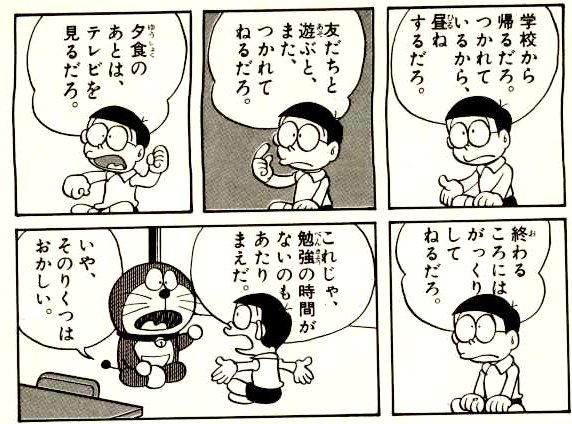
"Menes!" (1:20)
"Nyaruko, if you interfere with the love life of another, you will be scratched by the cats of Ulthar." (1:26)
There are two references here:
* Cthuko's yelp and following line are referencing Menes, an orphan boy from "The Cats of Ulthar", a short story written by H. P. Lovecraft and first published in 1920. Menes, who lost his parents to a plague, lives with a traveling caravan. His only companion is a small black cat. When the caravan stops at the city of Ulthar, the cat is butchered by an old couple who enjoy trapping and violently killing any cats who venture onto their property. In retribution, Menes calls down a curse upon the couple, and they are devoured by the cats of Ulthar.
* The Japanese line is "Hito no koiji wo jama suru yatsu ha urutaaru no neko ni hikkakareru yo" (人の恋路を邪魔する奴はウルタールの猫にひっかかれるよ). This is referencing a Japanese idiom that states, "Hito no koiji wo jama suru yatsu ha uma ni kerarete shinjimae" (人の恋路を邪魔する奴は馬に蹴られて死んじまえ), which translates to "He who interferes with the love life of another ought to be kicked to death by a horse".S2
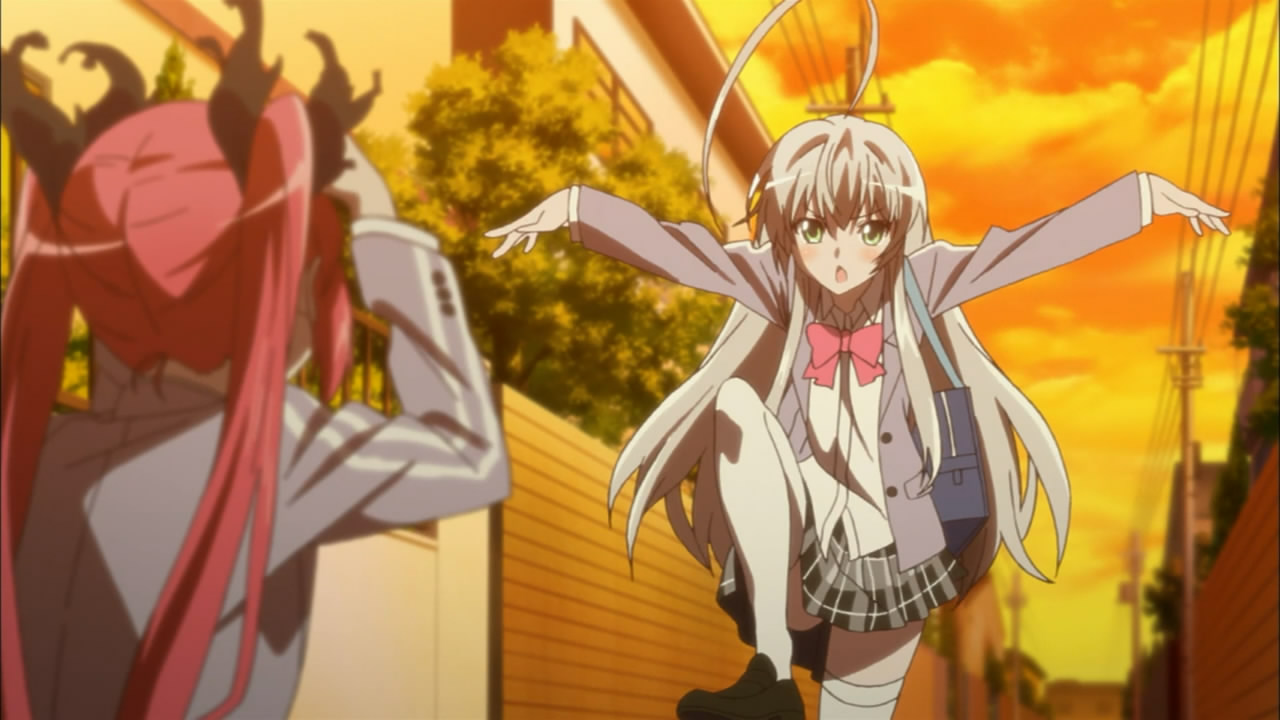
(1:32)
This is a repeat of a reference in episode 1 at 14:11. The pose at this time is referencing "araburu taka no poozu" (荒ぶる鷹のポーズ), "pose of the wild hawk", done by Kamiyama Venus (神山ビーナス) in "Kamisama Kazoku" (神様家族), "God Family", a light novel series written by Kuwashima Yoshikazu (桑島由一) and published from 2003 to 2008.S1 This pose also appears in episode 10 of the anime adaptation of this light novel series that aired in 2006. Image for reference:
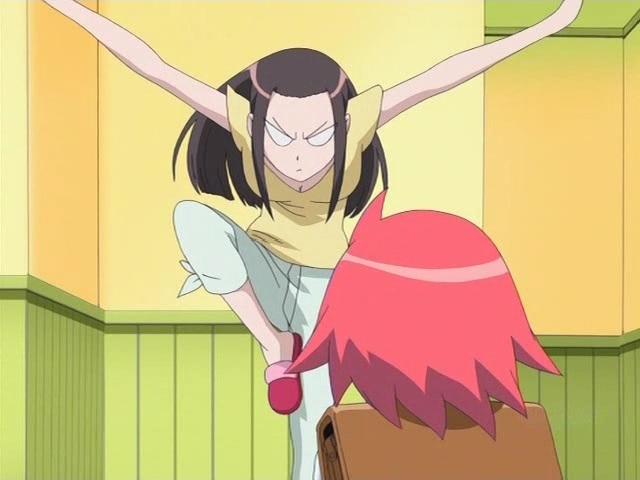
"I won't let you get away with it so easily." (1:37)
The Japanese line is "Sou ha toritsugi ga hannyuu shimasen yo!" (そうは取次が搬入しませんよ!), which more literally means "The distributors won't accept that!". This is referencing a Japanese expression and terminology used in the publishing industry.
* This is referencing a Japanese expression "Sou ha tonya ga orosanai" (そうは問屋が卸さない), which translates to "The wholesaler won't sell that".S1 This expression is a shortening of "Sonna yasune de ha tonya ga oroshiuri shinai" (そんな安値では問屋が卸売りしない), which translates to "The wholesaler won't sell that at such a low price". This expression is used describe how things seldom go as one wishes, and means things like "You'll never get away with it!" or "No such luck!".
* The origin behind this meaning lies in the supply chain of goods. Producers make goods and sell them to wholesalers. The wholesalers then sell the goods to retailers, who finally sell the goods to consumers. Producers who lacked sales know-how or financial strength to run a business often relied on wholesalers to sell their goods. Acting as the middleman between producers and retailers, wholesalers held powerful influence over the distribution process in Japan from the 1600's up until the mid 1900's. As a result, producers were often at the mercy of the wholesalers who dictated the terms of transactions, which gave rise to this expression.S9
* In the above expression, Nyaruko replaces "tonya" (問屋) with "toritsugi" (取次), which means distributor, and "orosanai" (卸さない) with "hannyuu shimasen" (搬入しません), which means "will not carry in". These are terms used in the publishing industry. A term combining these two terms is "toritsugi hannyuubi" (取次搬入日), which means "distributor carry in day" and refers to the period of time designated for the sending in of publications to distributors. These distributors are wholesalers who take in publications and distribute them to the bookstores where they will be sold to consumers.S5
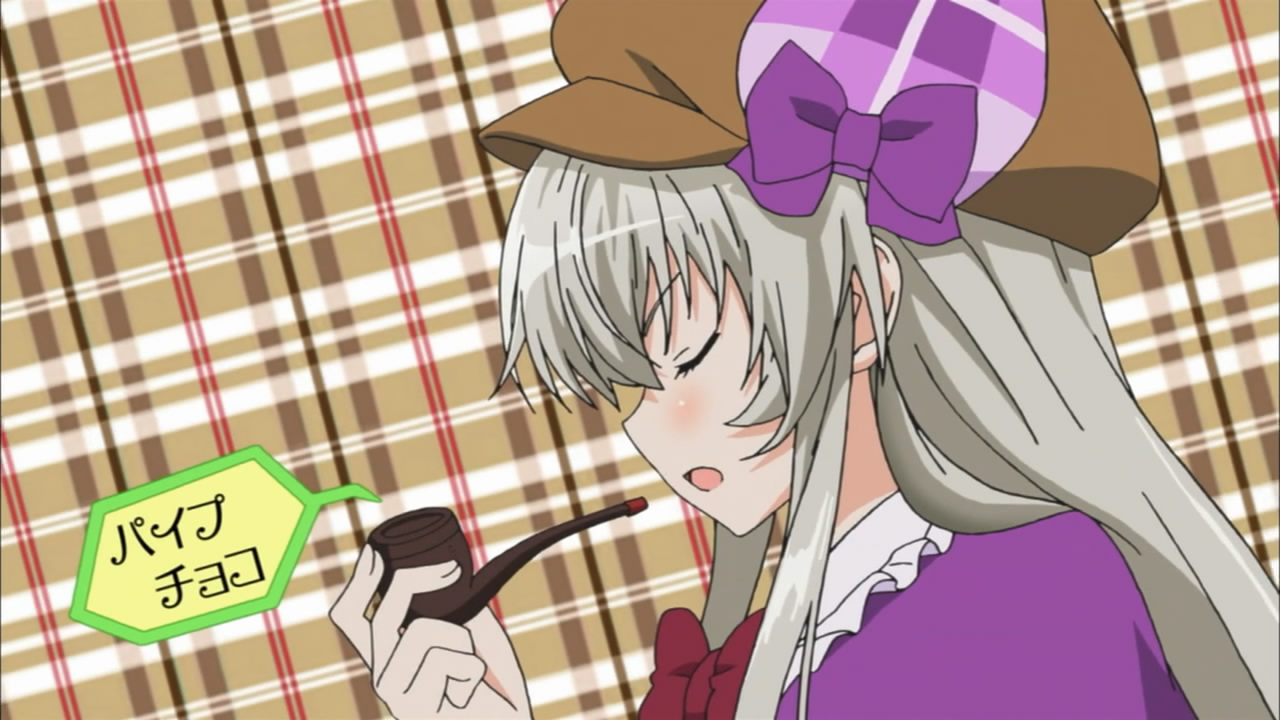
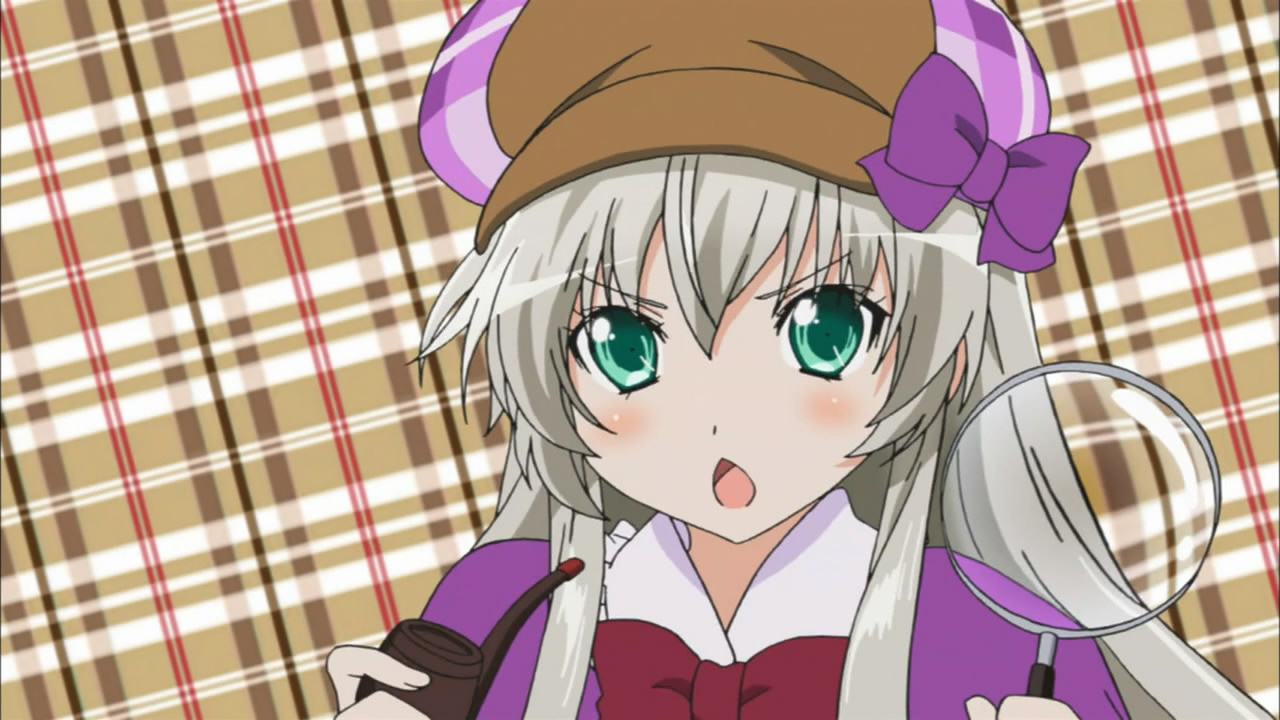
(3:41)
There are two references here:
* Nyaruko's outfit is referencing the outfits worn by the main characters in "Milky Holmes" (ミルキィホームズ), a media franchise produced by Bushiroad (ブシロード) starting from 2009. An anime adaptation titled "Tantei Opera Mirukii Hoomuzu" (探偵オペラ ミルキィホームズ), "Detective Opera Milky Holmes", aired in 2010. Image for reference:
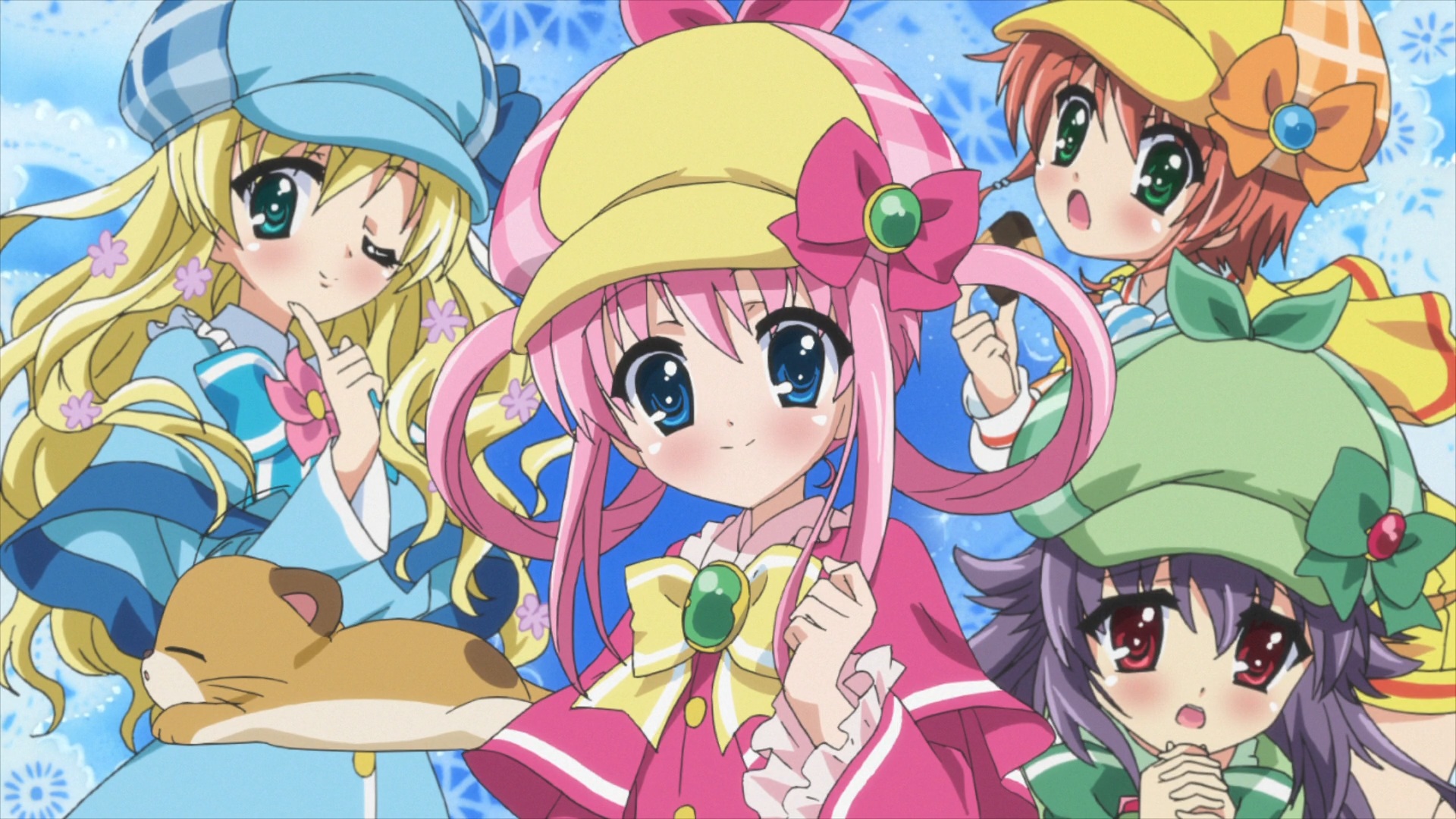
* Nyaruko's outfit, chocolate pipe, and magnifying glass are referencing Sherlock Holmes, a fictional detective created by Scottish author Arthur Conan Doyle. Holmes is often depicted as smoking a pipe and wearing a deerstalker cap and an Inverness cape. He often uses a magnifying glass during crime scene investigations.
"Hell Missionaries!" (3:58)
This is referencing a wrestling tag team by that name in "Kinnikuman" (キン肉マン), "Muscle Man", a manga series written by Yudetamago (ゆでたまご) and first published from 1979 to 1987.S2
"He's hopeless. I have to do something about this soon." (4:31)
The Japanese line is "Dame da koitsu... Hayaku nantoka shinai to" (駄目だこいつ・・・早くなんとかしないと). This is referencing the same line said by Yagami Light (夜神月) in chapter 26 of volume 4 of "DEATH NOTE" (デスノート), a manga series written by Oobata Tsugumi (大場つぐみ) and published from 2003 to 2006. In the original context this line translates to "This person is no good... I have to do something about him fast". This line has since become a popular phrase on Japanese message boards. Image for reference:
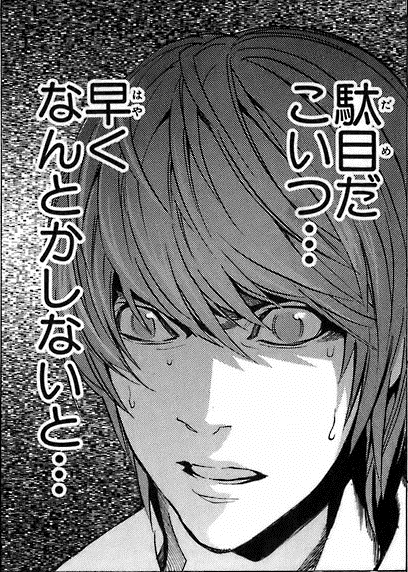
"It stood up, it stood up. The flag stood up." (4:34)
There are two references here:
* The Japanese line is "Tatta, tatta, furagu ga tatta" (立った、立った、フラグが立った). This is referencing a scene from episode 51 of "Arupusu no Shoujo Haiji" (アルプスの少女ハイジ), "Heidi, Girl of the Alps", an anime series that aired in 1974.S2 In the scene, Clara (クララ), a sickly young girl, is able to stand on her own and her friend Peter (ペーター) exclaims, "Tatta! Tatta! Kurara ga tatta!" (立った!立った!クララが立った!), translates to "She stood up! She stood up! Clara stood up!". Video for reference: https://youtube.com/watch?v=DL59L10zBBY
* This is referencing a flag, a common element in programming. Generally a flag is a variable that can be set to different values, such as true or false, and the value the flag is set to determines the result of some later operation. An example of this concept is in video games that contain branching storylines. Executing certain actions can set flags that change how the story progresses. The phrase "furagu ga tatta" (フラグが立った) literally translates to "the flag stood up" or "the flag rose up", but in this context the phrase means "the flag was set" or "the flag was activated".
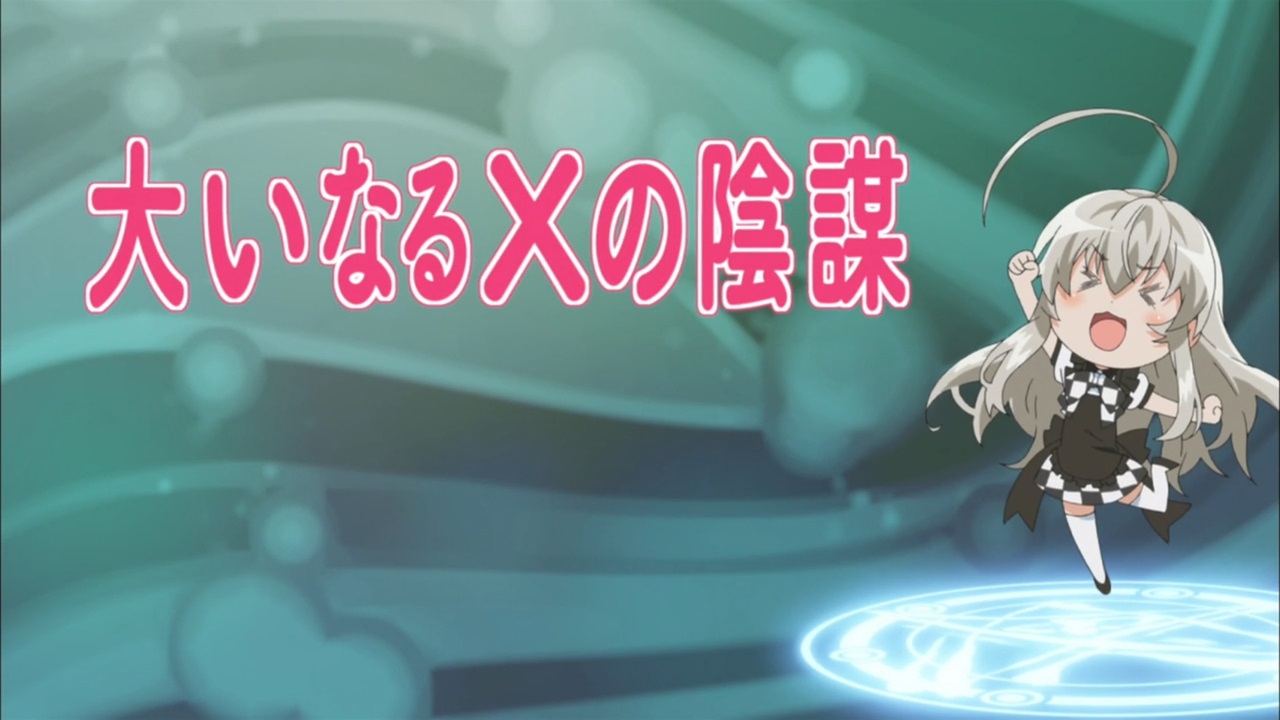
(4:37)
The title of this episode is "Ooinaru X no Inbou" (大いなるXの陰謀), which translates to "The Big X Conspiracy". This is referencing "The Big 'C'", a short story written by Brian Lumley and published in 1990. This story was translated into Japanese with the title "Ooinaru C" (大いなるC).S3
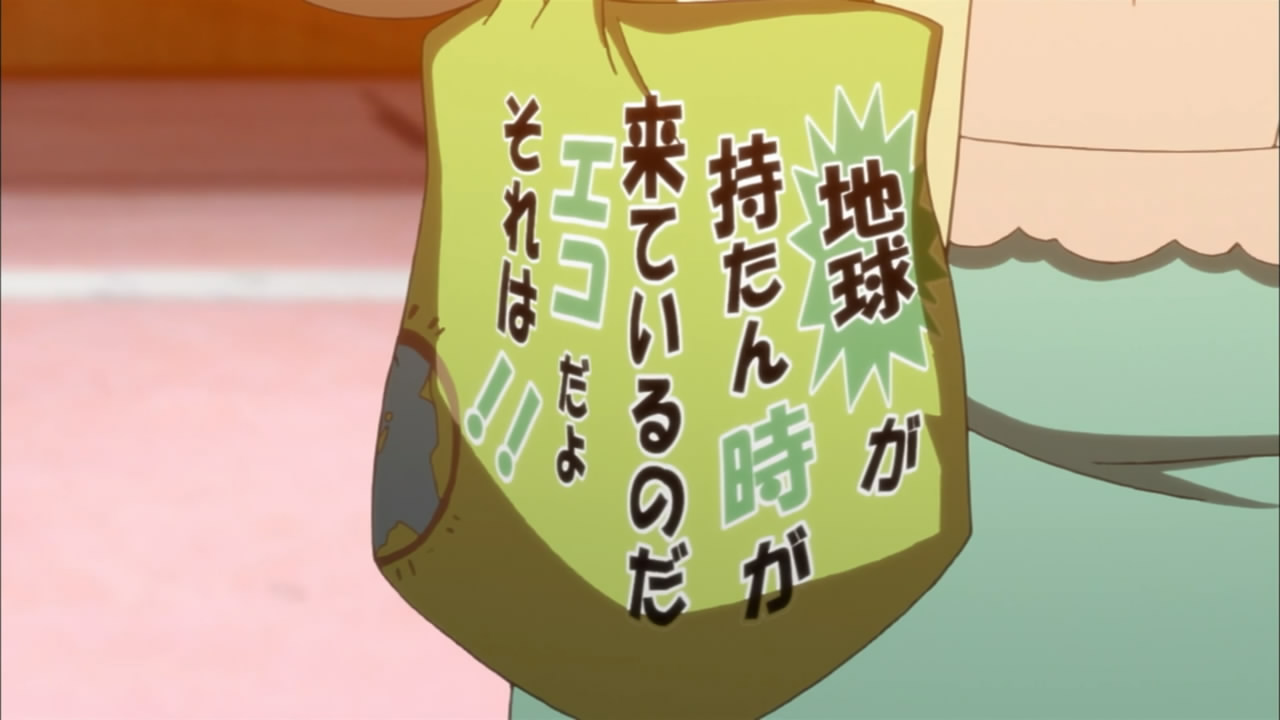
(4:50)
The text on Yoriko's eco friendly bags is as follows:
「地球が持たん時が来ているのだ」This text is referencing lines said by Amuro Ray (アムロ・レイ) and Char Aznable (シャア・アズナブル) in "Mobile Suit Gundam: Char's Counterattack" (機動戦士ガンダム 逆襲のシャア), a movie released in 1988.S1 The original lines go as follows:
「エコだよぞれは!!」
"Chikyuu ga motan toki ga kiteiru no da"
"Eko da sore ha!!"
"The Earth cannot hold out any longer"
"That's Eco!!"
アムロ: 「なんでこんなものを地球に落とす!?これでは、地球が寒くなって人が住めなくなる!核の冬が来るぞ!」As it can be seen, the text on Yoriko's bags is a pun on how "eco" sounds like "ego".
シャー: 「地球に住む者は自分達のことしか考えていない!だから抹殺すると宣言した!」
アムロ: 「人が人に罰を与えるなどと!」
シャー: 「私、シャア・アズナブルが粛正しようというのだ、アムロ!」
アムロ: 「エゴだよそれは!」
シャー: 「地球がもたんときが来ているのだ!」
Amuro: "Nande konna mono wo chikyuu ni otosu!? Kore de ha, chikyuu ga samuku natte hito ga sumenaku naru! Kaku no fuyu ga kuru zo!"
Char: "Chikyuu ni sumu mono ha jibun tachi no koto shika kangaeteinai! Dakara massatsu suru to sengen shita!"
Amuro: "Hito ga hito ni batsu wo ataeru nado to!"
Char: "Watashi, Shaa Azunaburu ga shukusei shiyou to iu no da, Amuro!"
Amuro: "Ego da yo sore ha!"
Char: "Chikyuu ga motan toki ga kiteiru no da!"
Amuro: "Why are you dropping such a thing on the Earth!? If you do, the Earth will freeze over and people won't be able to survive! A nuclear winter will come!"
Char: "The people of Earth think only of themselves! That's why I've declared to exterminate them all!"
Amuro: "Just one person has no right to punish humanity!"
Char: "I, Char Aznable, shall purge humanity, Amuro!"
Amuro: "That's your ego!"
Char: "The Earth cannot hold out any longer!"
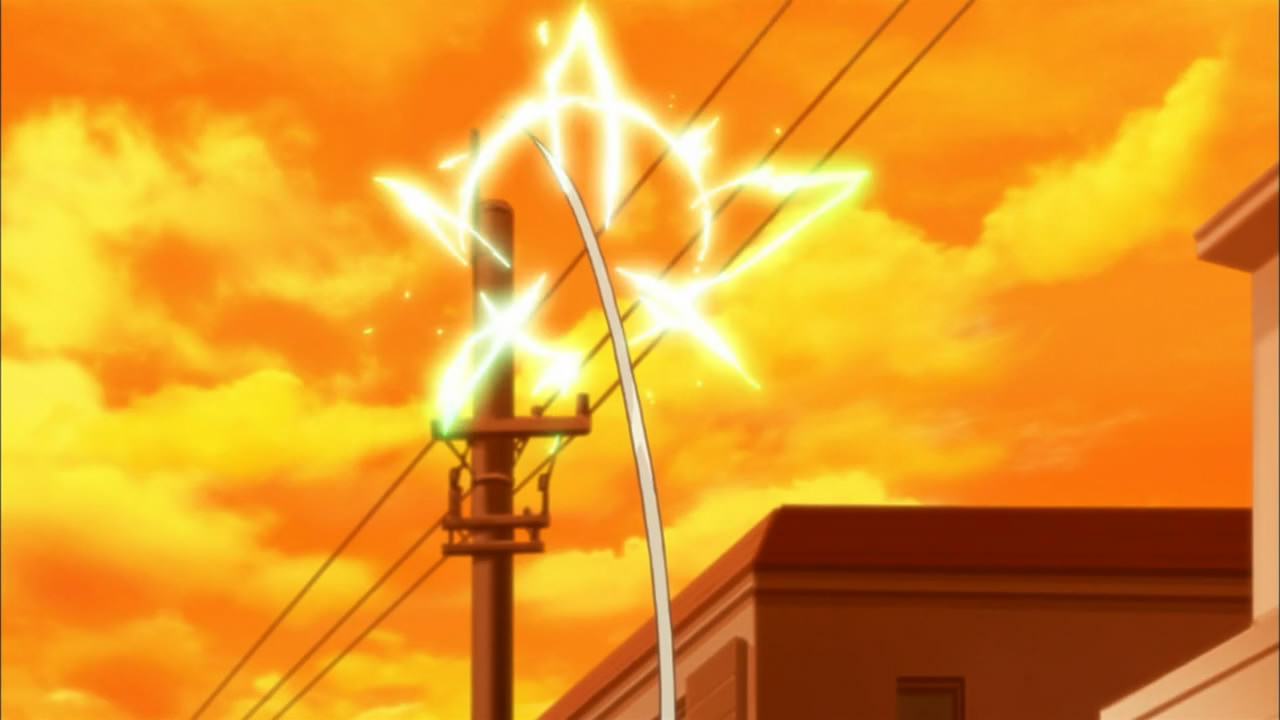
(6:03)
This is Nyaruko's "Jashin Reedaa" (邪神レーダー), "Evil God Radar", that first appeared in episode 2 at 6:37. This is referencing Kitarou (鬼太郎) from "GeGeGe no Kitarou" (ゲゲゲの鬼太郎), a manga series written by Mizuki Shigeru (水木しげる) and first published from 1960 to 1969. In the series Kitarou has an ability called "Yokai Antena" (妖怪アンテナ) that uses his hair to detect youkai or spiritual activity. When Kitarou's hair detects activity a strand of his hair sticks up.
"Yes, my lord!" (7:58)
This line is said by subordinates to address their superiors in "CODE GEASS Lelouch of the Rebellion" (コードギアス 反逆のルルーシュ), an anime series that aired from 2006 to 2007. This line is also commonly said by Sebastian Michaelis (セバスチャン・ミカエリス) in "Kuro Shitsuji" (黒執事), "Black Butler", a manga series written by Toboso Yana (枢やな) and published starting from 2006.S2
"Get out of the way, Cthuko. Otherwise I can't kill her." (8:24)
The Japanese line is "Dokinasai Kuuko. Soitsu korosenai" (どきなさいクー子。そいつ殺せない). This is referencing a famous incident said to have occurred in the MMORPG "Ragnarok Online". Someone shouted "Onii-chan doite! Soitsu korosenai!" (お兄ちゃんどいて!そいつ殺せない!), which translates to "Move aside bro! Otherwise I can't kill that guy!".S1 (Thanks convexity for translation help)
"Gyafun!" (8:49)
The Japanese line is "Gyafun!" (ぎゃふん!). This is a line often said by Harune Aira (春音あいら) in "Pretty Rhythm: Aurora Dream" (プリティーリズム・オーロラドリーム), an anime series that aired from 2011 to 2012.S3 On a related note, Nyaruko's voice actor, Asumi Kana (阿澄佳奈), also voices Aira. Video for reference: https://www.nicovideo.jp/watch/sm17747657

(9:00)
As mentioned in episode 4, this car is the Delorean DMC-12.
"Most everything can be solved with a karate kick." (9:17)
"What do you think you are, a school girl detective?" (9:22)
These lines are referencing Higuchi Sayaka (樋口さやか), the protagonist of "Ruruie Antiiku" (るるいえあんてぃーく), "R'lyeh Antique", an RPG replay book based on the "Call of Cthulhu" RPG that was written by Uchiyama Yasujirou (内山靖二郎) and published in 2009. Sayaka is a high school girl who longs to be a detective. She has gotten involved in many incidents concerning evil gods (邪神 jashin) and each time she fights back with her signature karate kick.S1 Specifically, Nyaruko's line in Japanese is "Taitei no koto ha karate kikku de kaiketsu desu" (大抵の事は空手キックで解決です). This is referencing Sayaka's catch phrase, "Karate kikku de kaiketsu shimasu!" (空手キックで解決します!), which translates to "I'll settle it with a karate kick!".S2
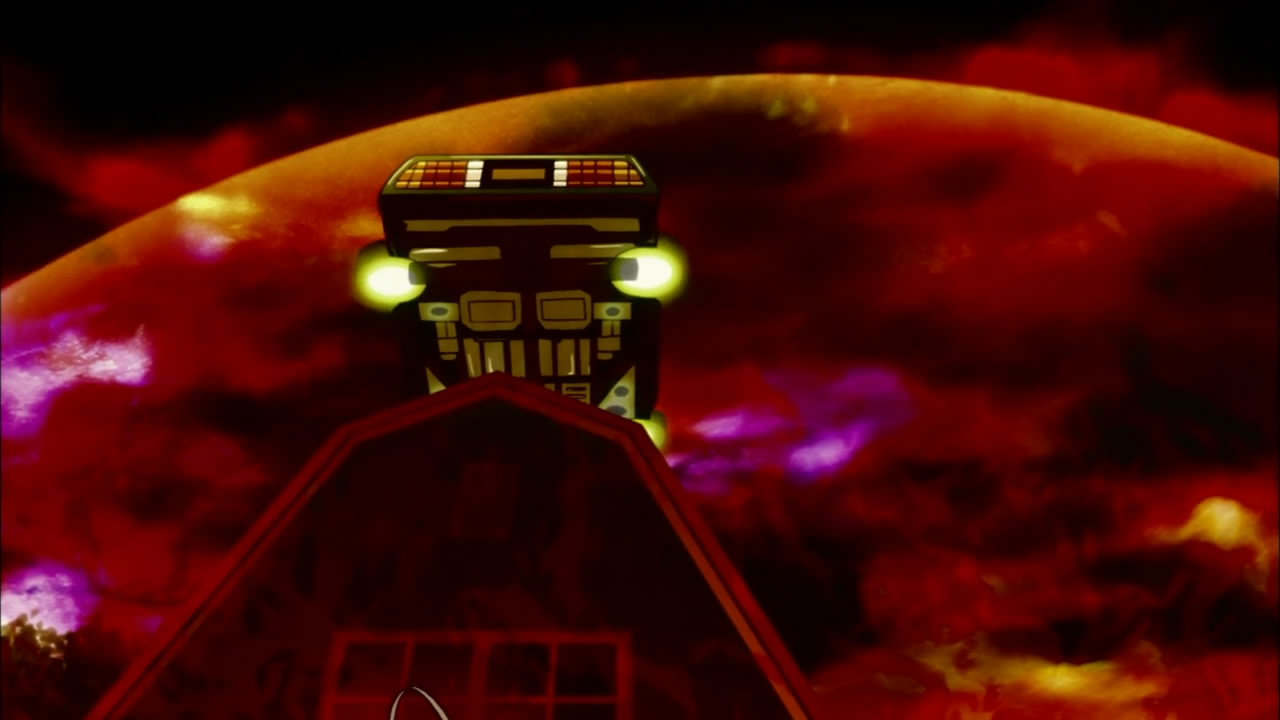
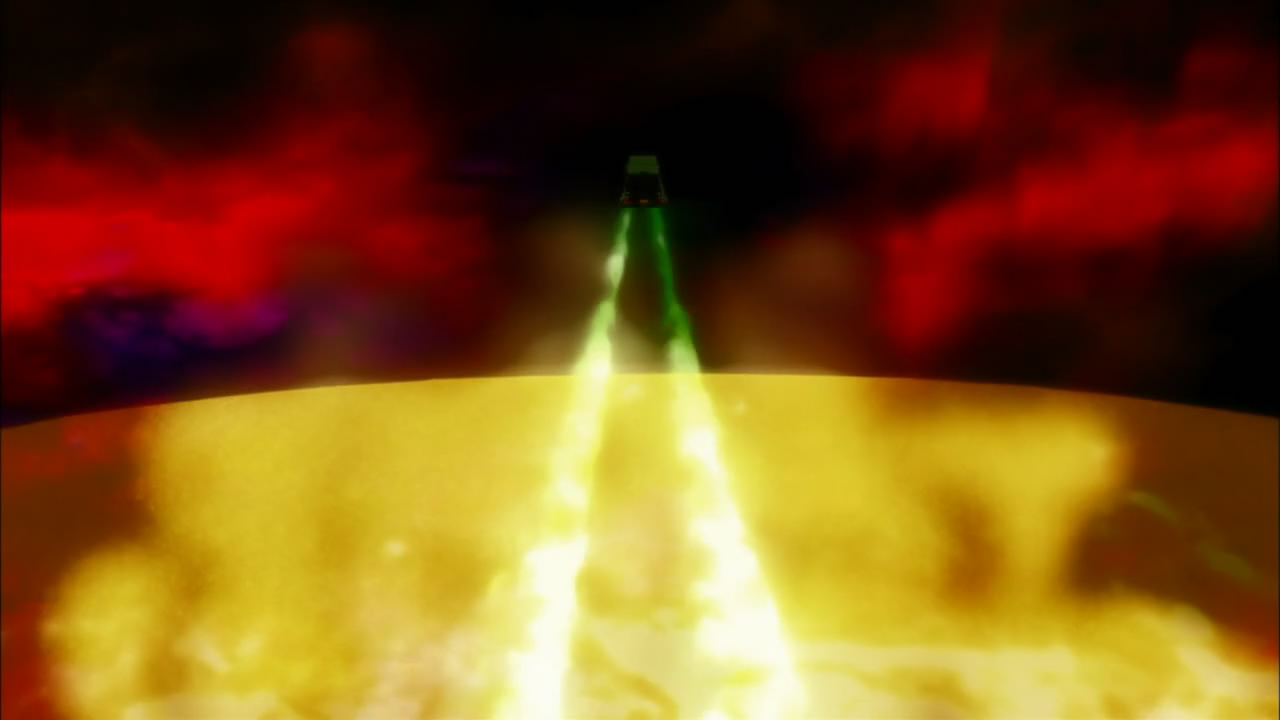
(9:35)
This is a reference specifically to the Delorean in the "Back to the Future" series in which the car is used as a time machine. When it flies its wheels go to a horizontal orientation. When it goes back it time it starts to give off electrical discharge and then leaves behind a trail of fire where the tires would have tread. Video for reference: https://youtu.be/lfnAb11wKQc?t=30s
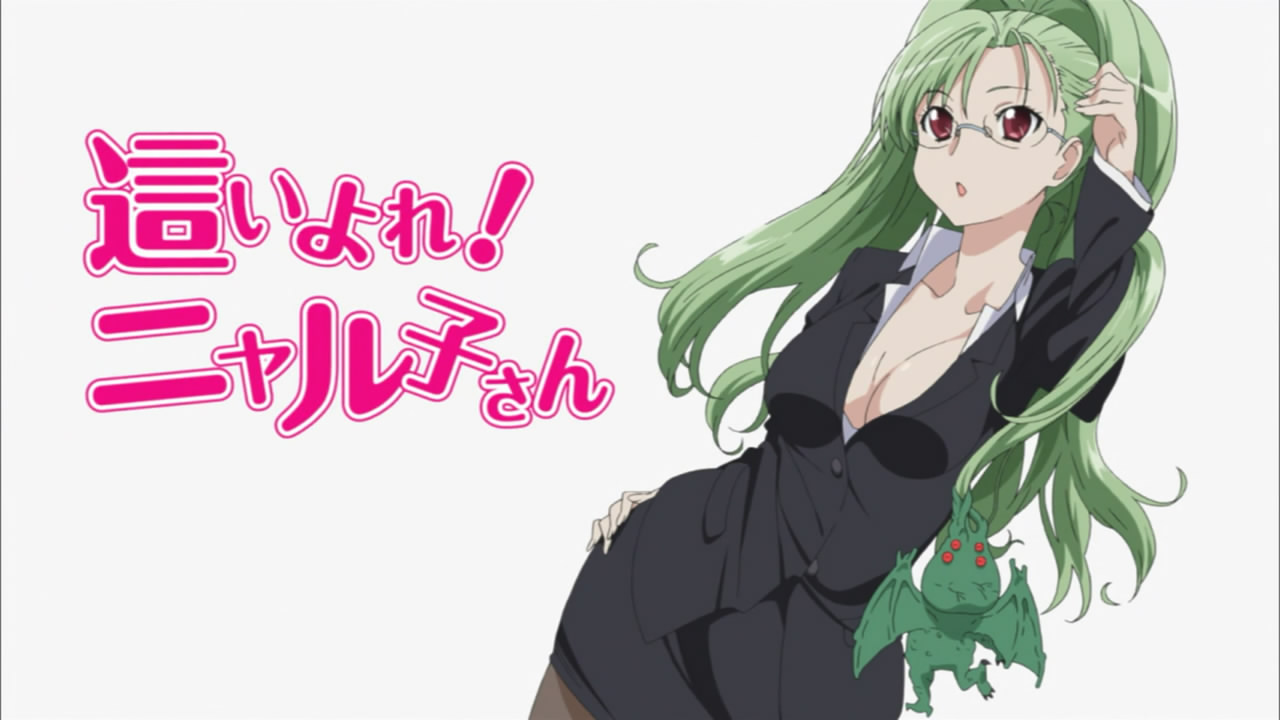
(10:32)
This character is Luhy Jistone (ルーヒー・ジストーン), and her name will be properly mentioned in episode 6. The little green creature clinging to Luhy's hair is referencing the appearance of Cthulhu in the Cthulhu Mythos. In "The Call of Cthulhu", a short story written by H. P. Lovecraft and first published in 1928, Cthulhu is described as follows:
"... a monster of vaguely anthropoid outline, but with an octopus-like head whose face was a mass of feelers, a scaly, rubbery-looking body, prodigious claws on hind and fore feet, and long, narrow wings behind."
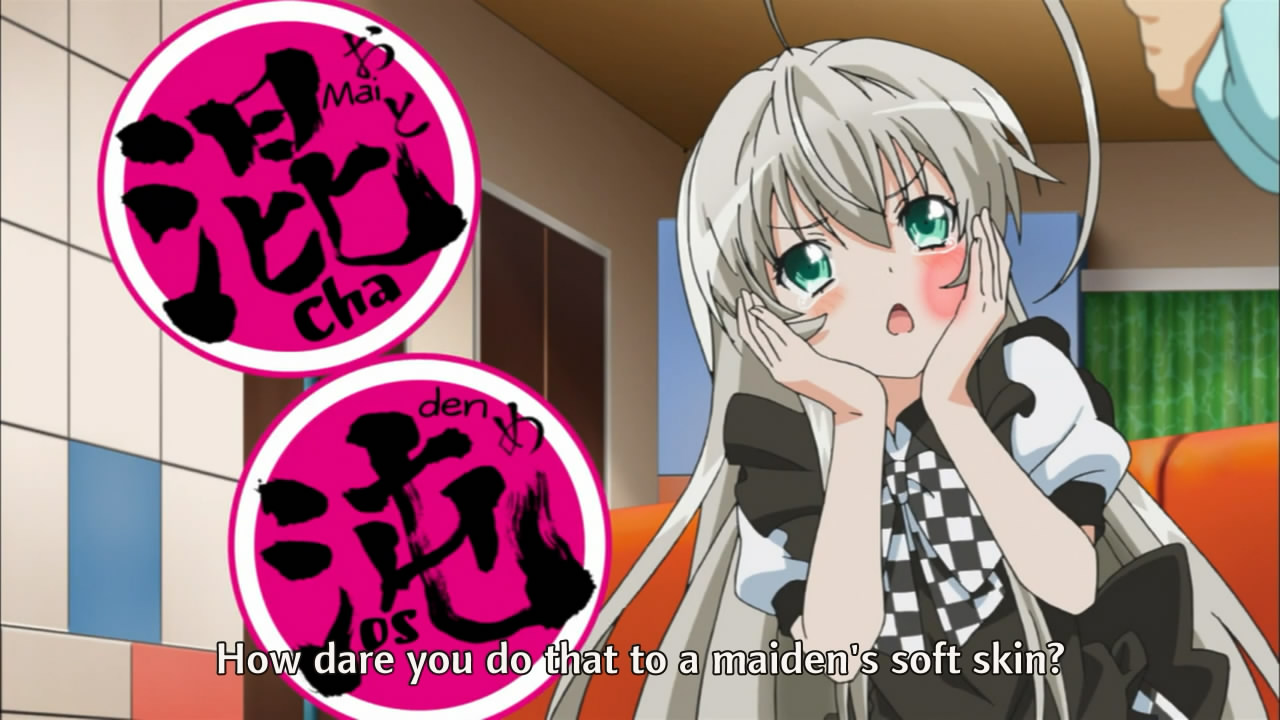
(11:06)
There are two large characters that read "kon" and "ton" (混沌) meaning "chaos", but there are also smaller characters above those that read "oto" and "me" (おとめ) meaning "maiden", stating that the text is written as "chaos" but is read as "maiden". Like in episode 1 at 21:30, this seems to be inspired by an adult game based on the Cthulhu Mythos and released by Cyc in 2010. The title of the game is 「ク・リトル・リトル~魔女(オトメ)の使役(フレ)る、蟲神(テンシ)の触手~」 (Ku Ritoru Ritoru ~Otome no Fureru, Tenshi no Yubisaki~), in which the characters 「魔女」, normally read as "majo" to mean "witch", are stated to be read as 「オトメ」 (otome), which means "maiden".

(11:34)
The game console on the left is the Net Yarouze (ネットやろうぜ), a development kit version of the PlayStation that enabled users to program PlayStation games and applications.S1 Image for reference:
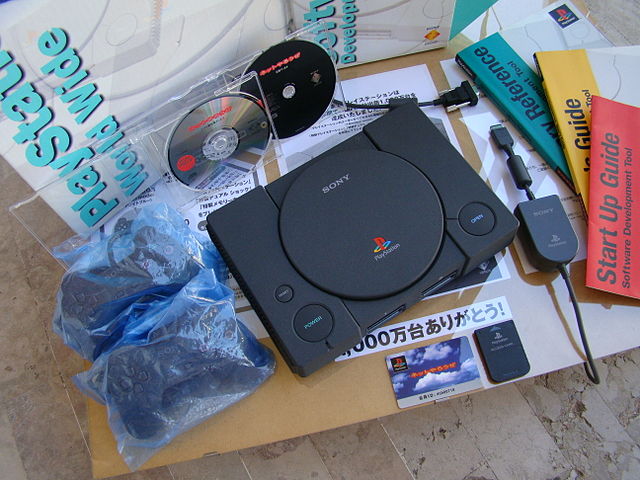
Source of image: https://en.wikipedia.org/wiki/File:Net-Yaroze-Full-Sdk.jpg
"I'm sure it's more useless than a Thomasson to anyone else." (12:30)
"Thomasson" is a term used to describe ordinary but useless urban objects and structures that happen to look like conceptual artwork, coined by Japanese artist Akasegawa Genpei. The term is named after Gary Thomasson, a professional baseball player who signed with the Yomiuri Giants to the biggest contract ever given to a player in the Nippon league, yet performed poorly throughout his 2 years with the team.S1
Nyaruko's ring tone (13:13)
Nyaruko's ring tone is a brief excerpt from "Kurogane no Sutoraibaa" (黒鋼のストライバー), "Iron Striver", a song sung by Kitamura Eri (喜多村英梨) and Hatano Wataru (羽多野渉), the voice actors of Mahiro and Yoichi respectively. The song was also used during the "Iron Stiver" show that Nyaruko watches in episode 1 at 3:09. The song was released on the "Taiyou Iwaku Moeyo Kaosu" (太陽曰く燃えよカオス) CD single.
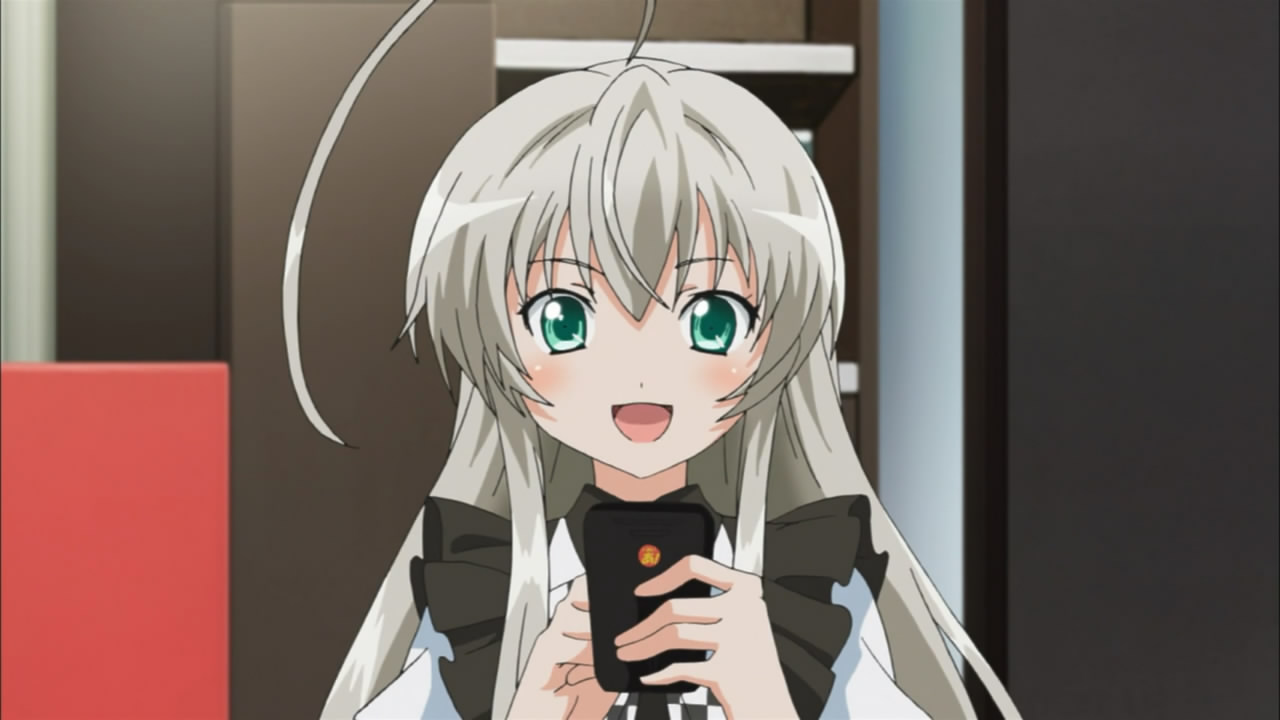
(13:17)
There are two references here, both repeats from episode 1 at 3:20.
* The small red logo on Nyaruko's phone is referencing "Azumanga Daioh" (あずまんが大王), a manga series written by Azuma Kiyohiko (あずまきよひこ) and published from 1999 to 2002. In particular, the yellow text within a red speech bubble appears to be referencing the same color scheme used for the title of the anime adaptation of this series that aired in 2002. In addition, the big 「あ」 character within the speech bubble is referencing how at times in this series characters have been depicted with a speech bubble containing the character 「あ」. Images for reference:
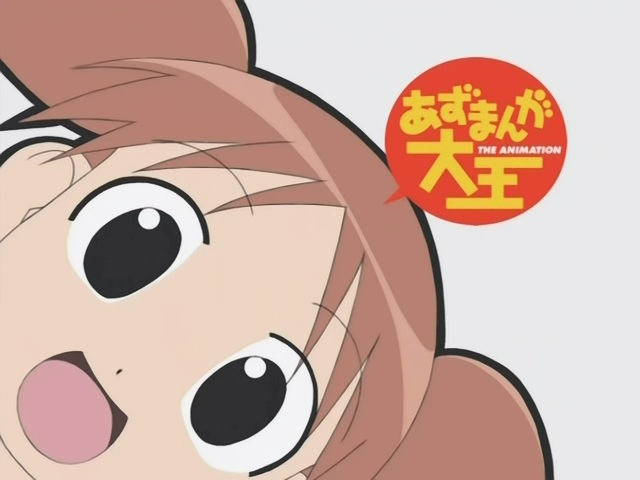
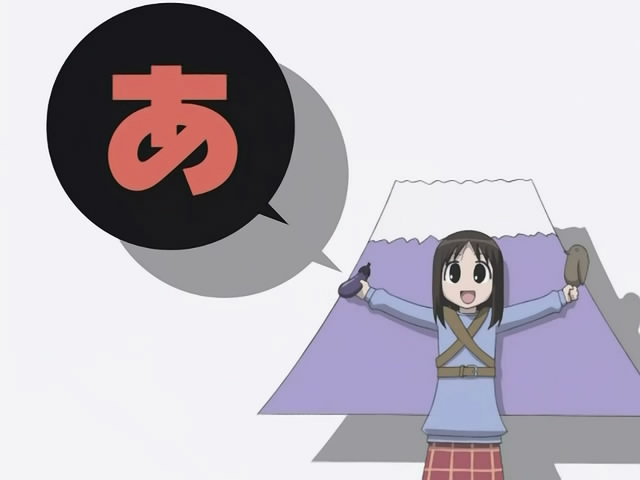
* The text within the logo reads "Ia Ia!" (いあいあ!). "Iä" is a term that is used in the Cthulhu Mythos, often in relation to the fantastic creatures that appear in the mythos. In "The Shadow Over Innsmouth", a story written by H. P. Lovecraft and first published in 1936, a chant using the term goes as follows:
"Iä! Iä! Cthulhu fhtagn! Ph’nglui mglw’nafh Cthulhu R’lyeh wgah-nagl fhtagn"
"You fool. Cthuko is dead." (13:22)
The Japanese line is "Bakame, Kuuko ha shinda wa" (莫迦め、クー子は死んだわ). This referencing a line from "The Statement of Randolph Carter", a short story written by H. P. Lovecraft and first published in 1920.S2 The original line goes, "Bakame, Uooren ha shinda wa!" (莫迦め、ウォーランは死んだわ!), which translates to "You fool, Warren is DEAD!". In addition, Nyaruko says this line in a telephone call. This is referencing how the original line is also said in a telephone call.S1
"47°9'S, 126°43'W." (13:59)
These are the exact coordinates at which the sunken city R'lyeh is located, as stated in "The Call of Cthulhu", a short story written by H. P. Lovecraft and first published in 1928.
"Only associates of the Cthulhu Corporation can access the sunken R'lyeh Land." (14:17)
There are two references here:
* "Kabushikigaisha Kutouruu" (株式会社クトゥルー), "Cthulhu Corporation", is referencing Cthulhu from the Cthulhu Mythos.
* R'lyeh is a sunken city where Cthulhu is imprisoned in the Cthulhu Mythos.

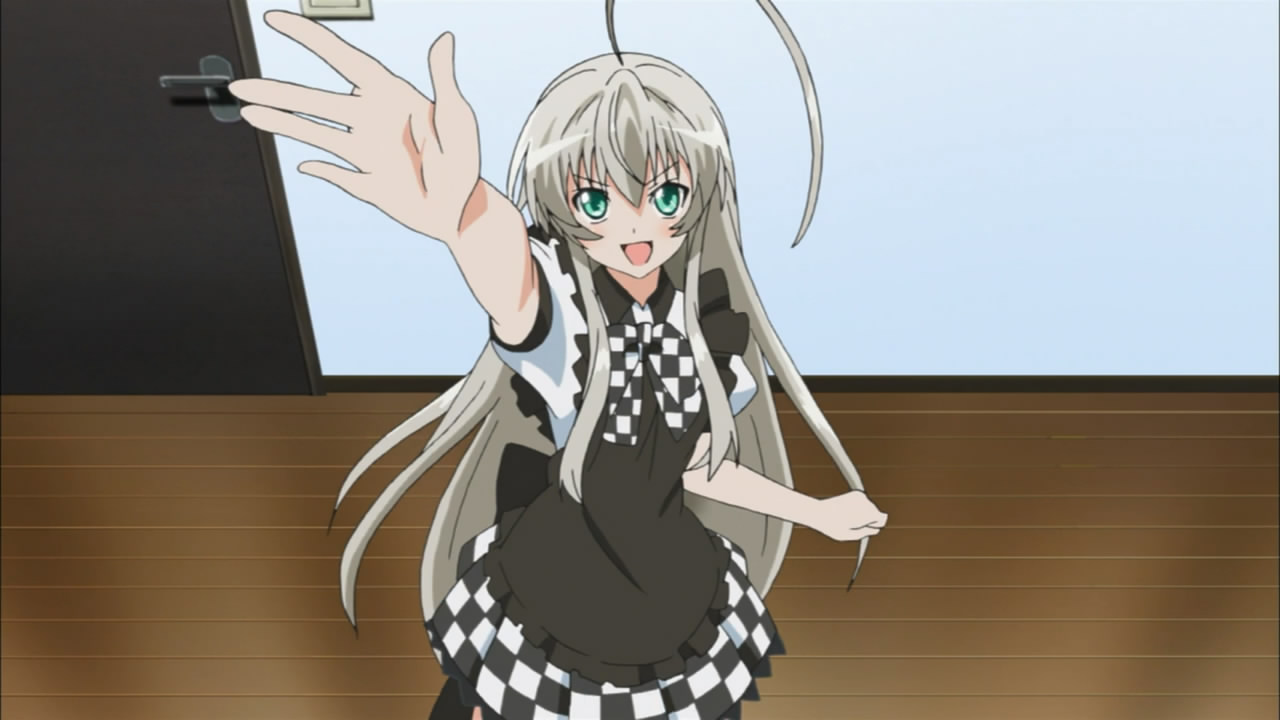
(15:03)
Nyaruko's poses are referencing those of Kamen Rider Fourze in "Kamen Rider Fourze" (仮面ライダーフォーゼ), a Japanese TV show about a masked super hero that aired from 2011 to 2012.S1 Images for reference:
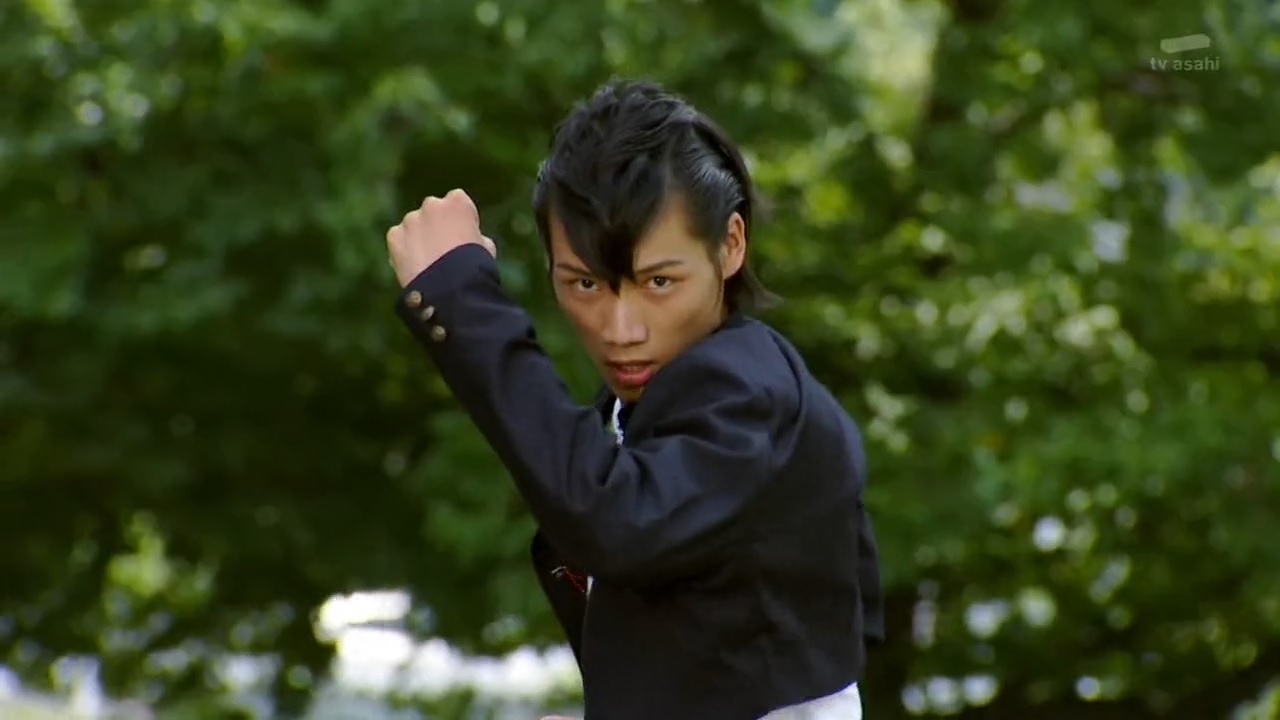
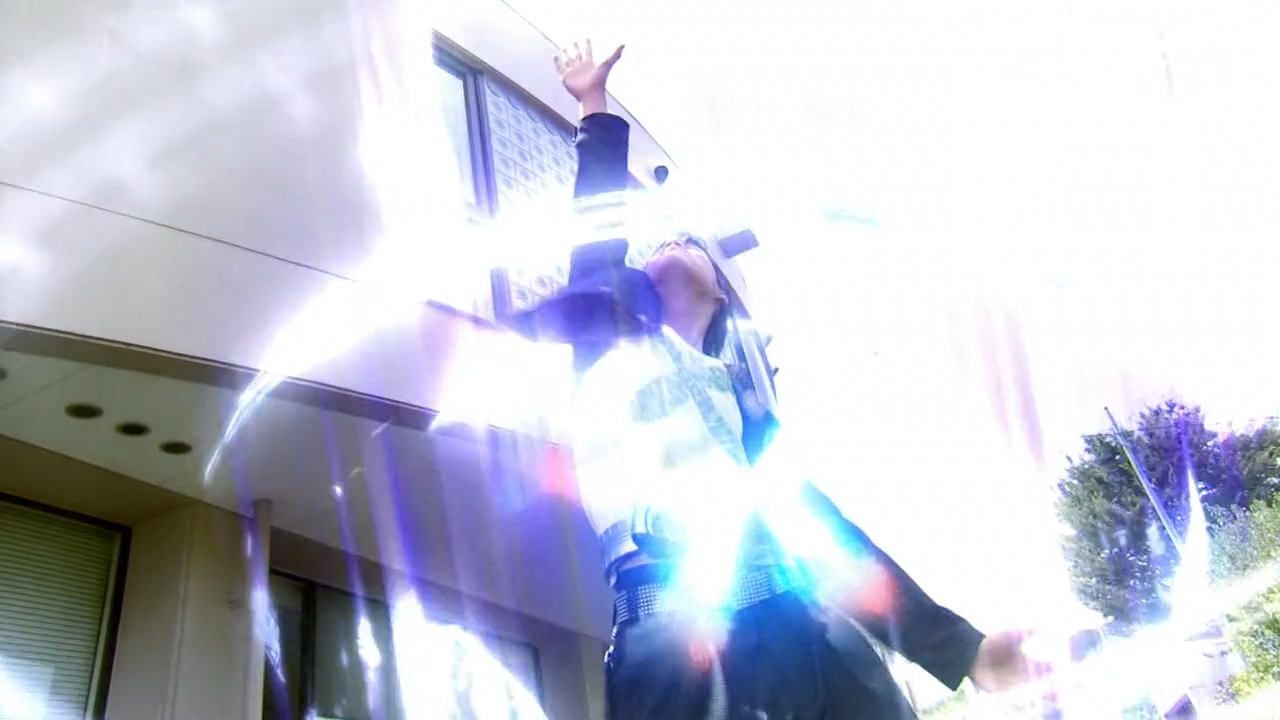
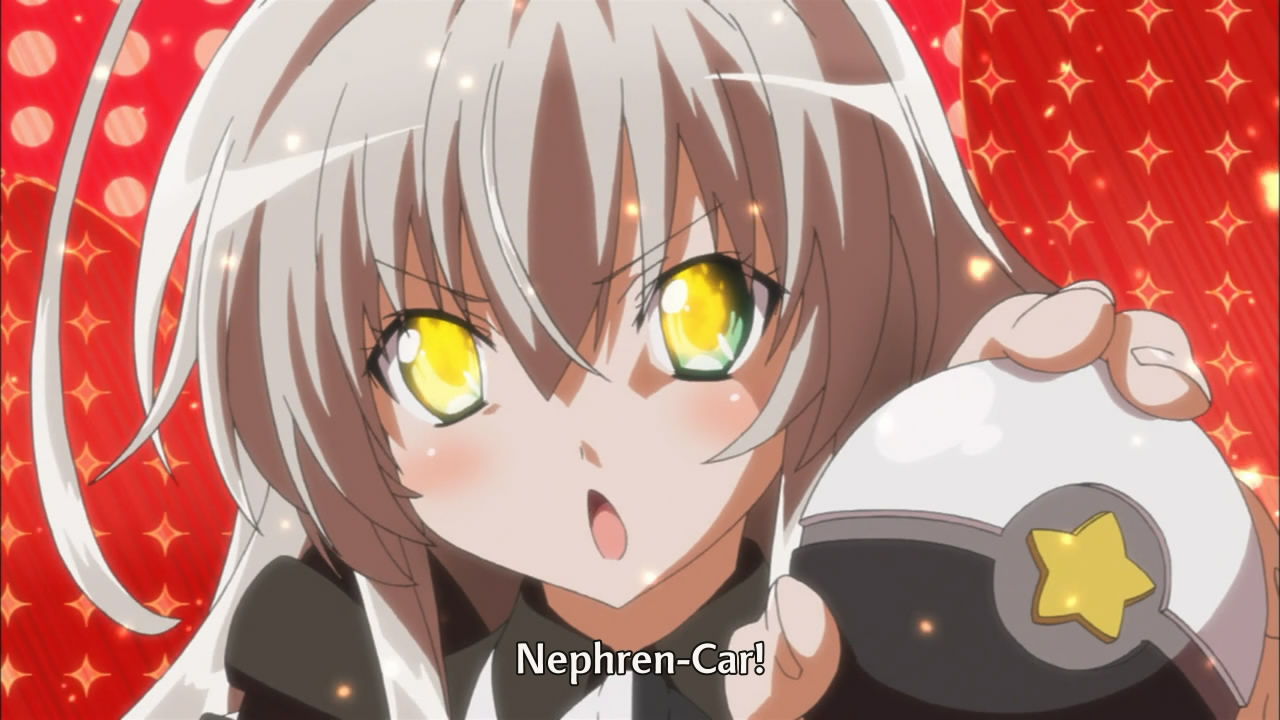
"Nephren-Car! I choose you!" (15:26)
The Japanese line is "Nefurenkaa! Kimi ni kimeta!" (ネフレンカー!君に決めた!). Both the line and the pose are repeats of references in episode 1 at 19:27 to the "Pokemon" series. Nyaruko is holding what distinctly resembles a Pokeball. "Pokemon! I choose you!" (Pokemon! Kimi ni kimeta! ポケモン! きみにきめた!) is the title of the very first episode of "Pokemon", and "I choose you!" is an often used phrase in the show. Below are screens of the pose being done by Ash in "Pokemon: The First Movie" and Gary in the first season opening sequence:


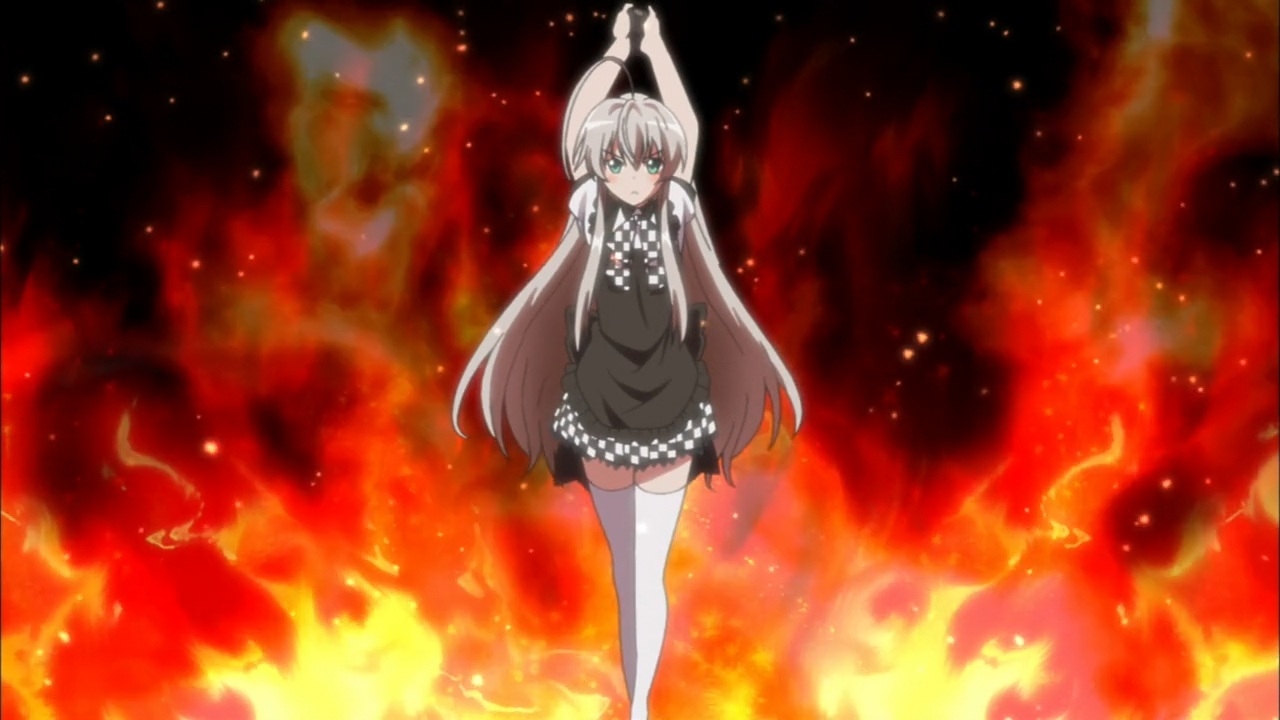
(15:29)
This is a repeat of a reference in episode 1 at 19:30. This scene is referencing Hoshi Hyuuma (星飛雄馬) from "Kyojin no Hoshi" (巨人の星), "Star of the Giants", a manga series written by Kajiwara Ikki (梶原一騎) and published from 1966 to 1971. Nyaruko's pitching form is referencing that of Hoshi when he does his special technique, "Dai Riigu Booru Ichigou" (大リーグボール1号), "Major League Ball #1". Images for reference:

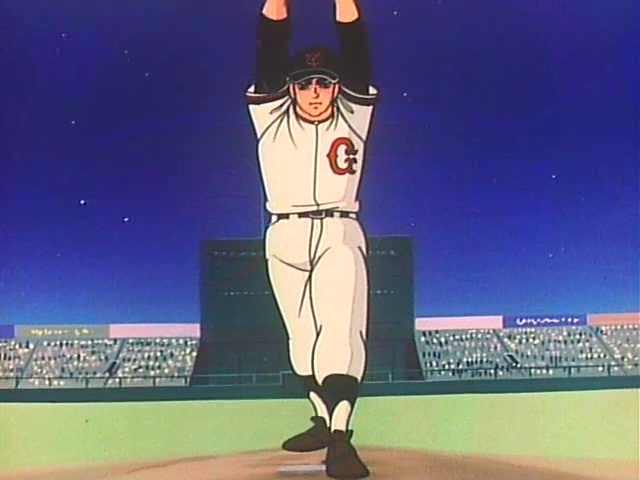
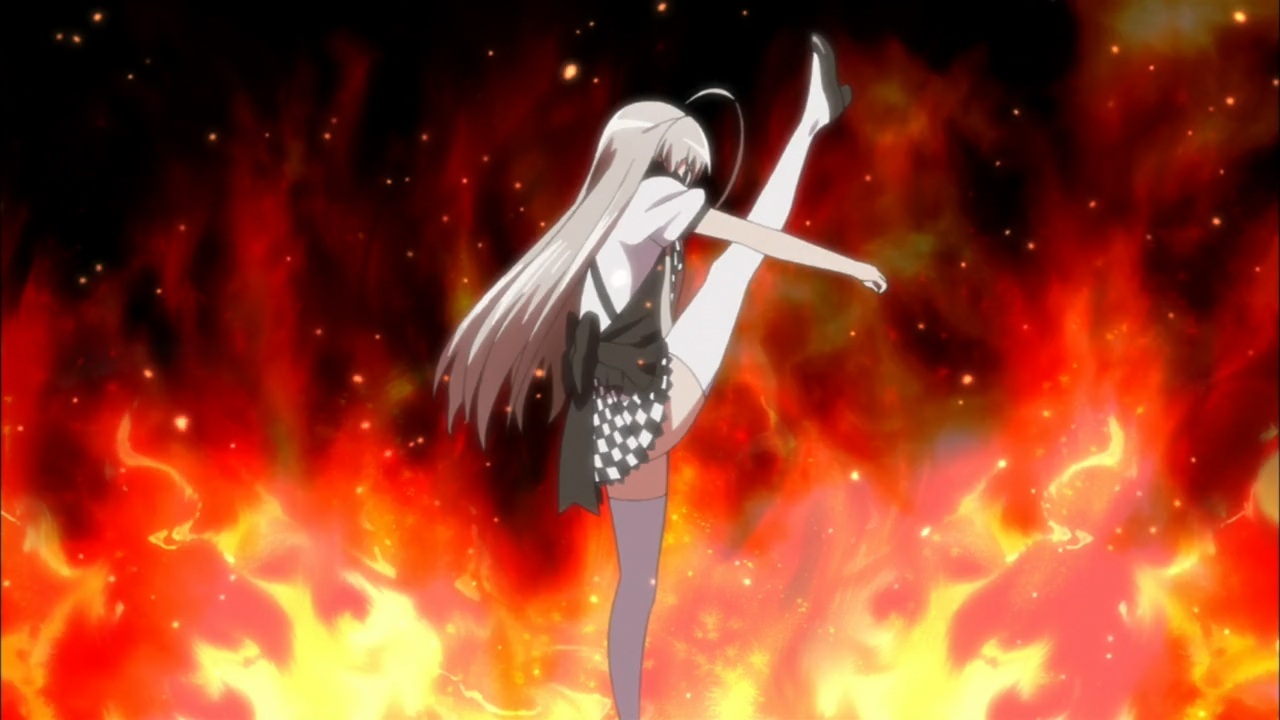
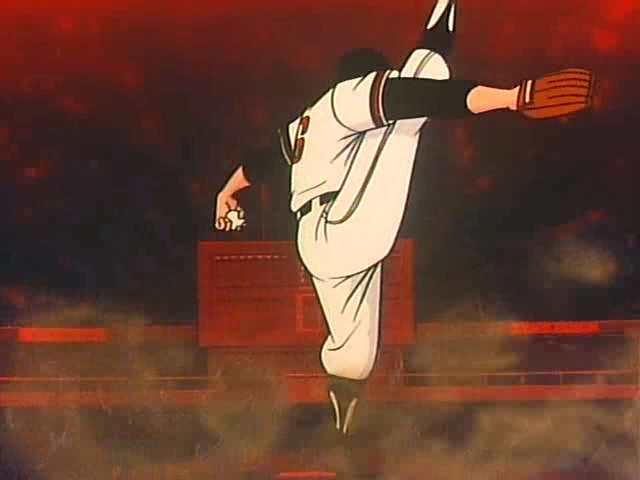
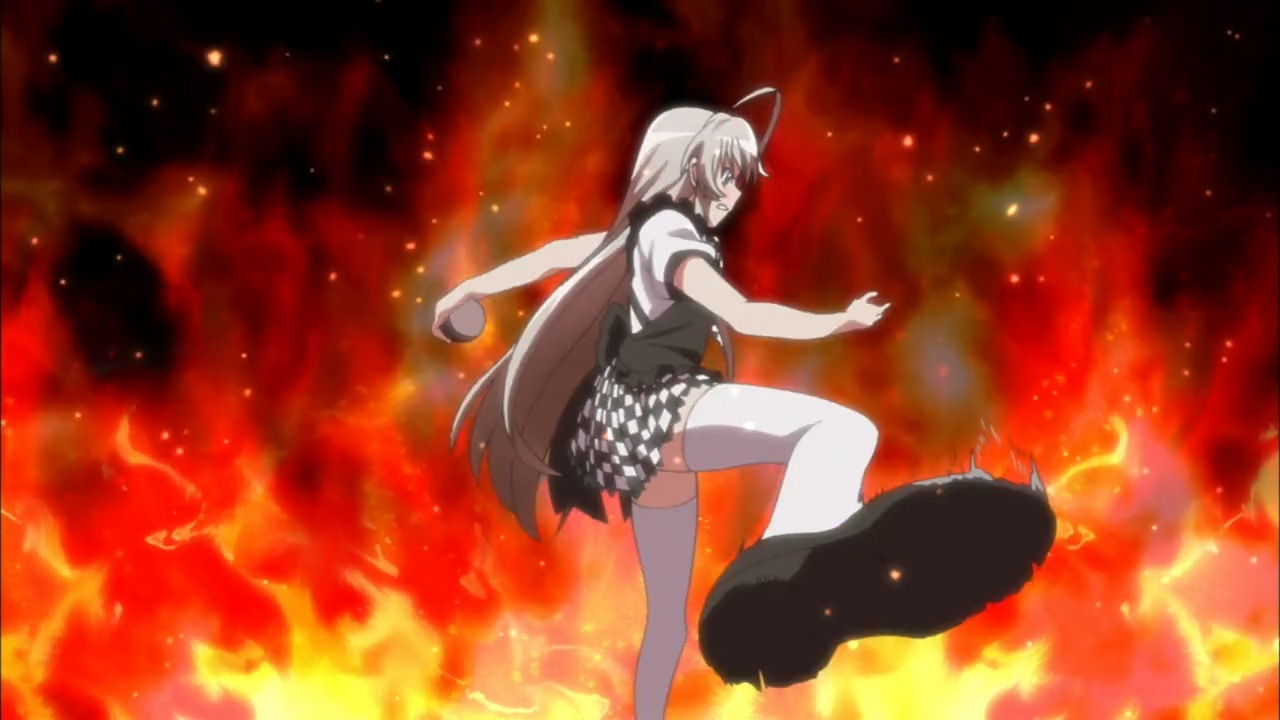
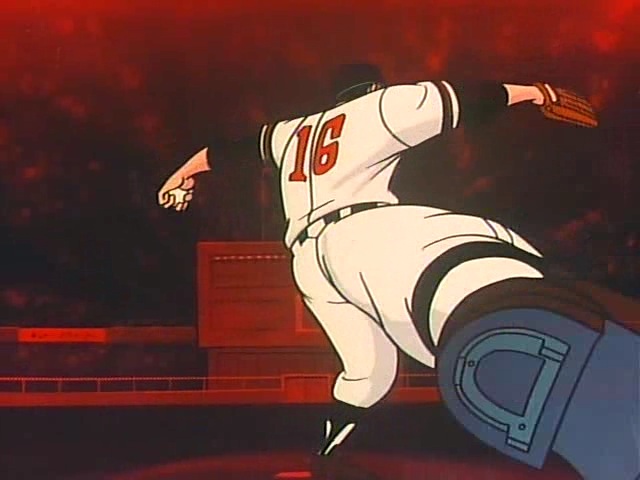
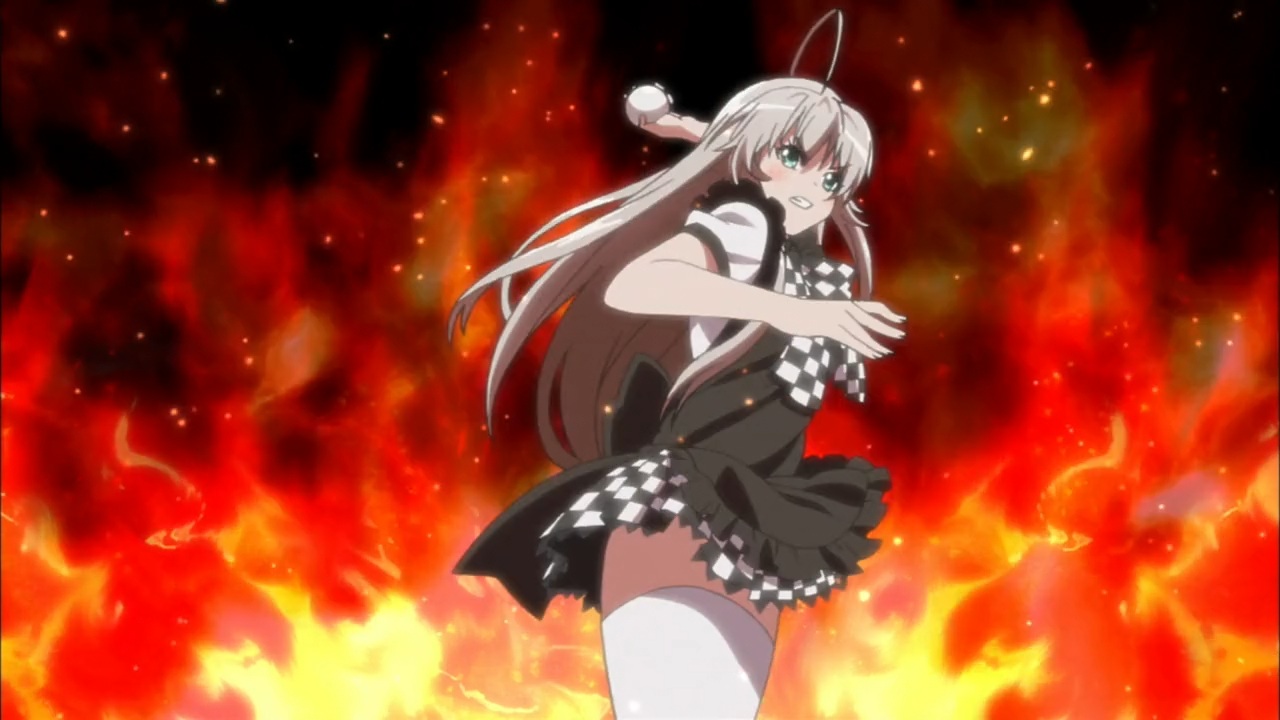
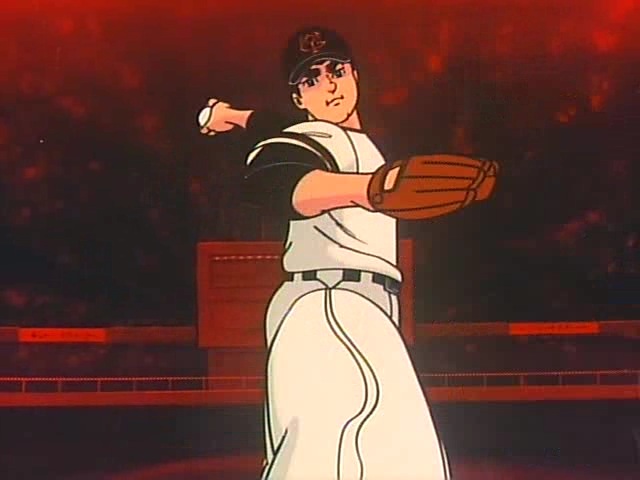
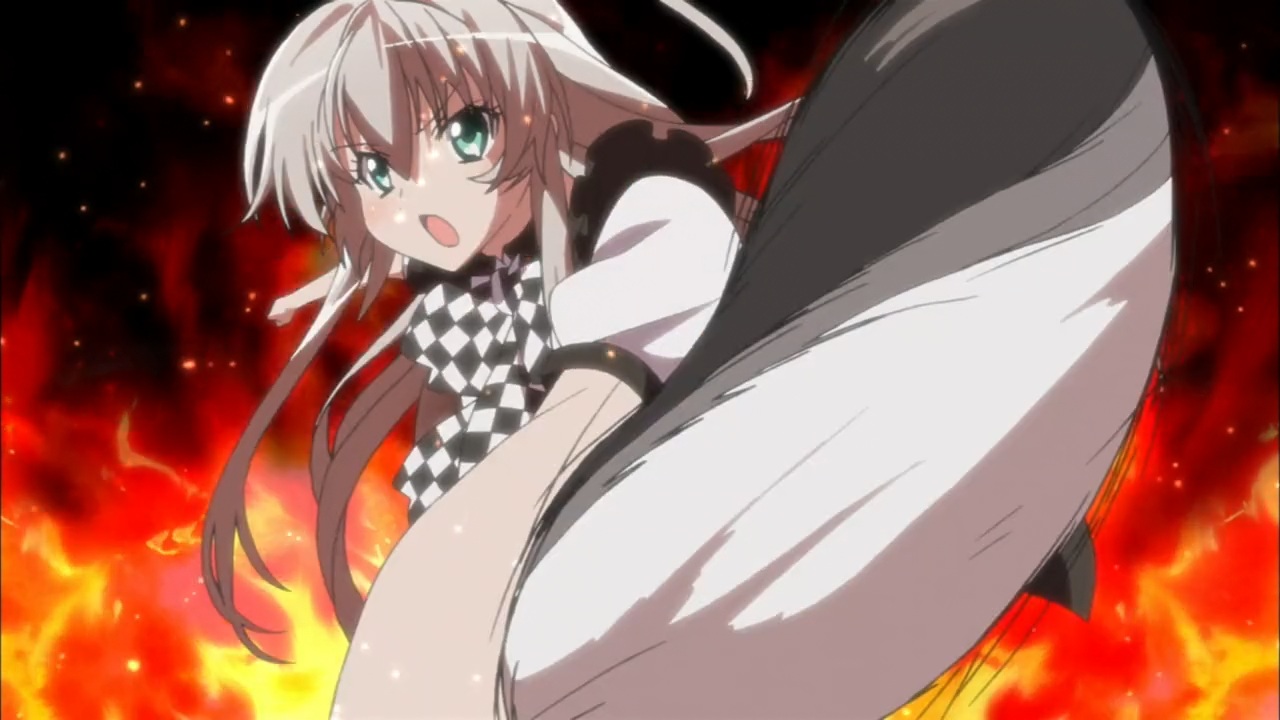
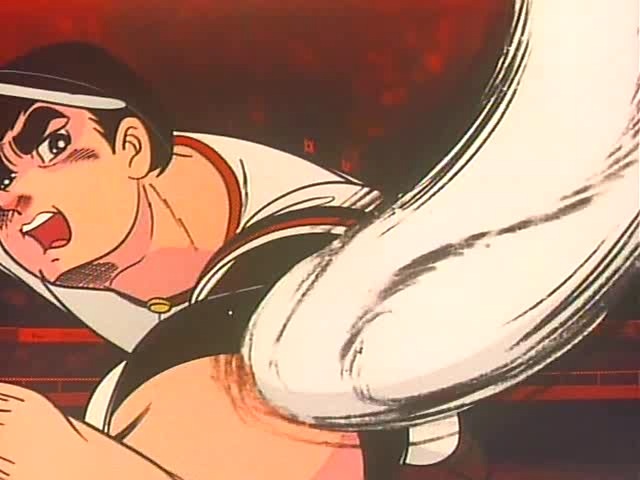
"This is my favorite car, special amphibious vehicle, Nephren-Car!" (15:34)
This is referencing Nephren-Ka, an Egyptian pharaoh in the Cthulhu Mythos who worships Nyarlathotep and created a cult in his name.S1

(15:57)
The map in the background is referencing the world map from "Dragon Quest II: Luminaries of the Legendary Line" (ドラゴンクエストII 悪霊の神々), a video game first released in 1987.S2 Images for reference (flipped then original):
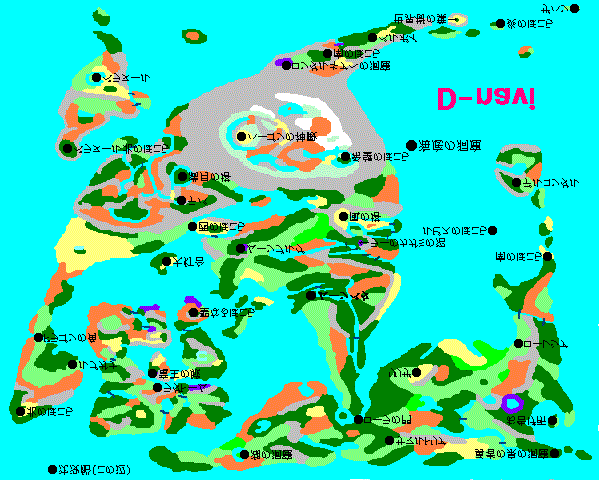
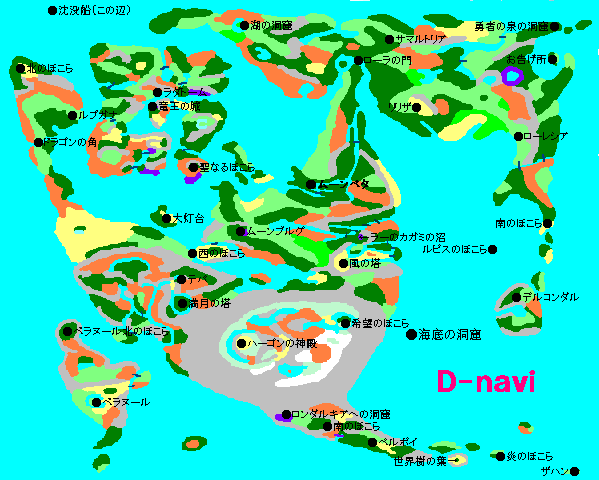
Source of image: http://www.d-navi.info/dq2/map.html
"Flywheel activated! Energy charged to 120%!" (16:22)
The Japanese line is "Furaihoiiru shidou! Enerugii juuten hyaku nijuu paasento!" (フライホイール始動!エネルギー充填120パーセント!). This is referencing a line said by Tokugawa Hikozaemon (徳川彦左衛門) during the take off sequence of Space Battleship Yamato in "Uchuu Senkan Yamato" (宇宙戦艦ヤマト) "Space Battleship Yamato", an anime series that aired from 1974 to 1975.S1 The original line is "Hadou enjin nai, enerugii juuten hyaku nijuu paasento! Furaihoiiru shidou!" (波動エンジン内、エネルギー充填120パーセント!フライホイール始動!), which translates to "Within the Wave Motion Engine, energy charged to 120%! Flywheel activated!".
"Even though it's an automatic, it can tackle Red Canyon and Fire Field just fine." (16:41)
Red Canyon and Fire Field are the names of race tracks in the "F-Zero" game series. Specifically, Red Canyon II and Fire Field are the final 2 courses in the hardest difficulty of the SNES version.S1
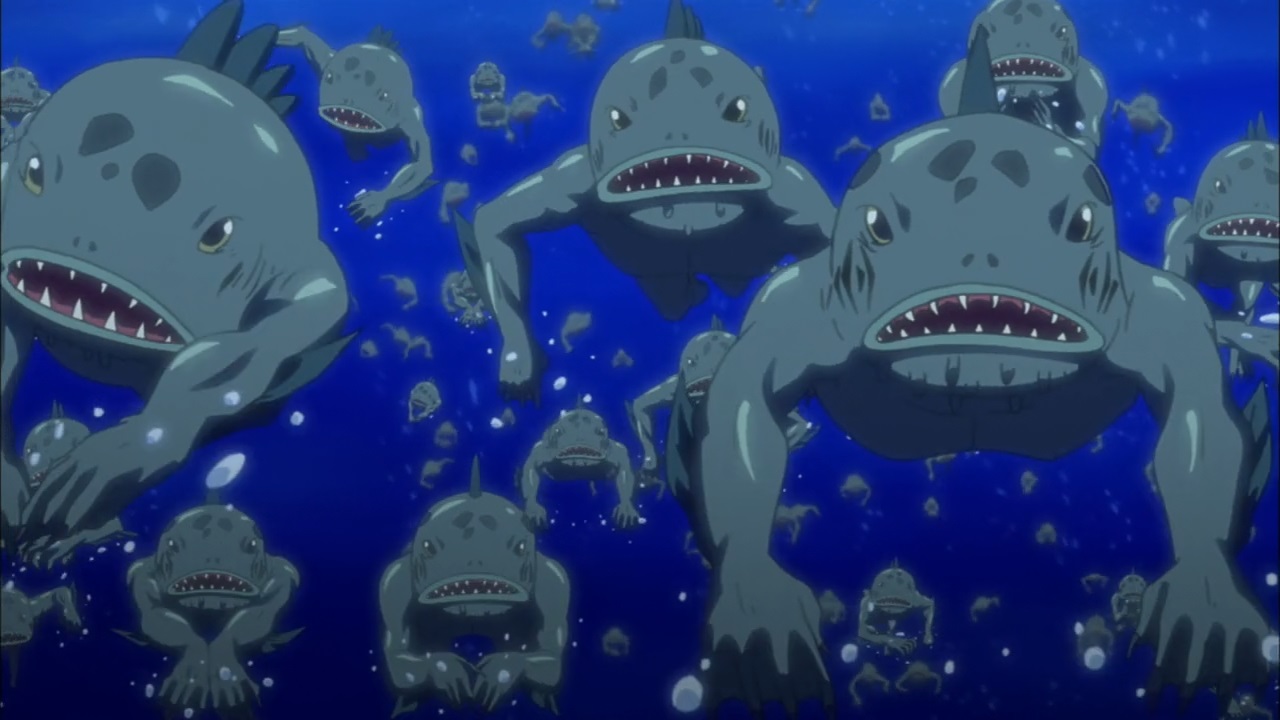
"Deep ones." (16:51)
Deep Ones are sea dwelling creatures in the Cthulhu Mythos. In "The Shadow Over Innsmouth", a story written by H. P. Lovecraft and first published in 1936, they are described as follows:
"I think their predominant colour was a greyish-green, though they had white bellies. They were mostly shiny and slippery, but the ridges of their backs were scaly. Their forms vaguely suggested the anthropoid, while their heads were the heads of fish, with prodigious bulging eyes that never closed. At the sides of their necks were palpitating gills, and their long paws were webbed."
"Nantoo!" (16:58)
The Japanese line is "Nantoo!" (なんとー!). This is referencing "Mobile Suit Gundam F91", (機動戦士ガンダムF91), a movie released in 1991.S2 The protagonist of the movie, Seabook Arno (シーブック・アノー), says the same line while dodging attacks from the mobile armor Rafflesia. Typically "nanto" (なんと) can mean "how" or "what". However, in context it seems that the phrase is used by Seabook as a battle cry with no specific meaning. Similarly, Nyaruko's use of the phrase doesn't seem to invoke any specific meaning.
"Almost. The gauge is almost..." (17:06)
This is referencing the giant robot Ideon from "Space Runaway Ideon" (伝説巨神イデオン), an anime series that aired from 1980 to 1981. In "Super Robot Wars" (スーパーロボット大戦), a series of video games series that began release starting in 1991, the Ideon has an Ide Gauge which increases as it is attacked. As the gauge increases Ideon's capabilities rise and various hidden abilities become unlocked.S1
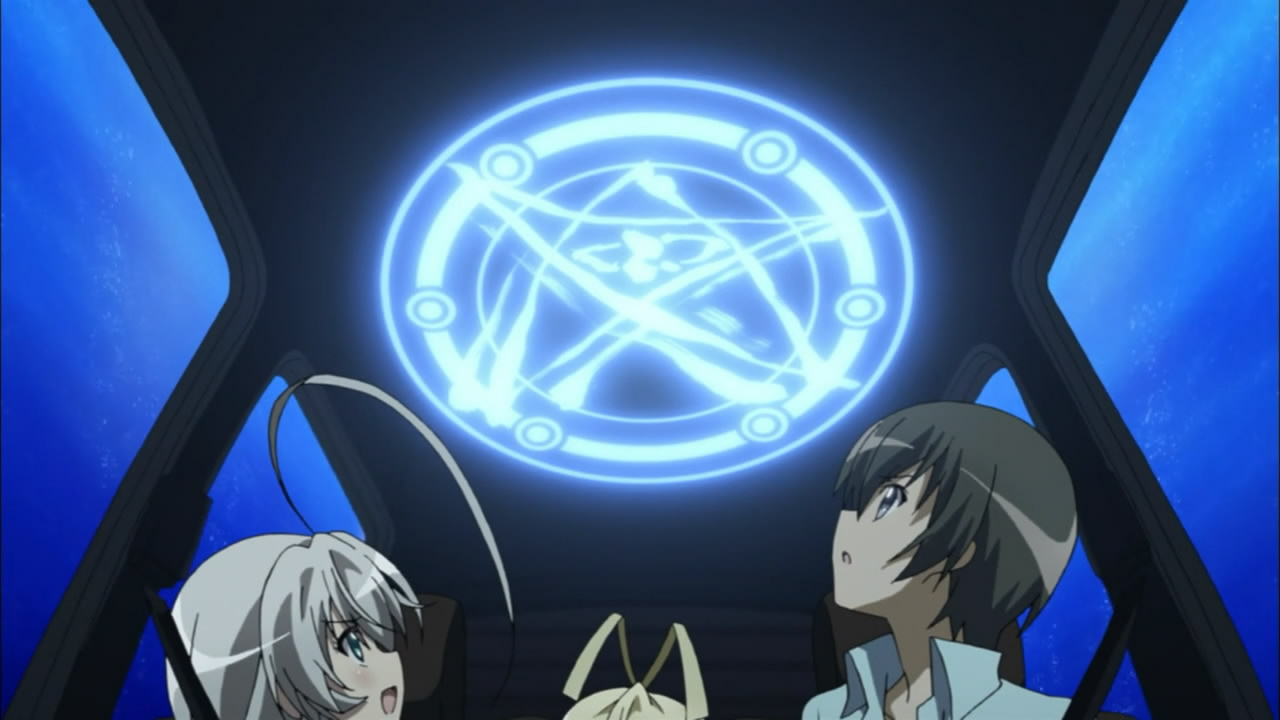
(17:10)
The symbol is referencing August Derleth's description the Elder Sign, a symbol that appears in the Cthulhu Mythos. Image from the 5th edition rule book for the "Call of Cthulhu" RPG for reference:

On a related note, this symbol is the same as that which appears below Nyaruko on the episode title screens.S6
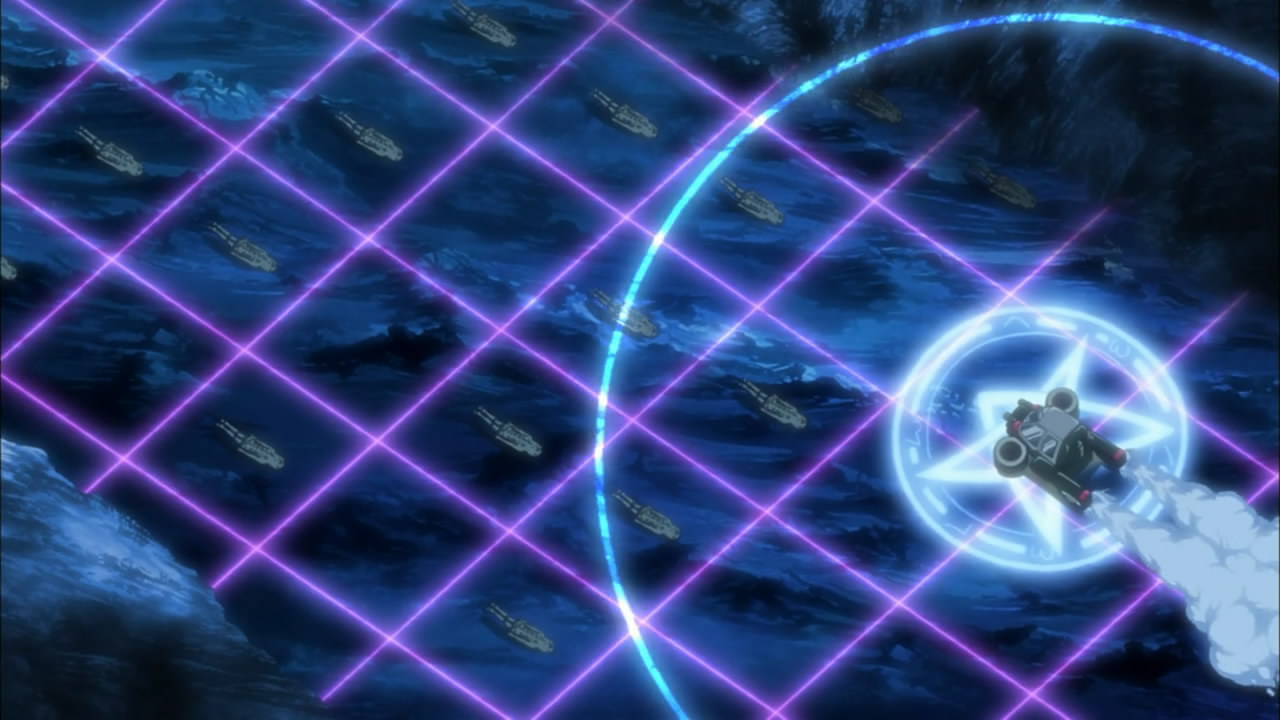
"Let's give it all our heart and soul and use our MAP weapons!" (17:13)
There are two references to "Super Robot Wars" series here:
* SRW is played on a grid like battlefield where each unit occupies a square on the grid, as depicted above. MAP weapons are able to attack multiple squares on the grid at once as opposed to a single target. Video for reference: https://youtube.com/watch?v=Bwmtze7EZ_E
* The Japanese line is "Tamashii to kiai wo kakete MAP heiki ikimasu yo!" (魂と気合をかけてMAP兵器いきますよ!). "Tamashii" (魂) and "Kiai" (気合), "Soul" and "Spirit", are two of many Spirit Commands that appear in the SRW series. Spirit Commands are power ups a player can use on characters to enhance their combat abilities. Soul causes the character's next attack to do 2.5 times more damage. Spirit increases the character's Will parameter by 10 points. At 17:35 Nyaruko also mentions the Spirit Command "Tekagen" (てかげん), "Mercy", which has the effect of leaving an enemy with 10 HP if the user's next attack would normally destroy the enemy and the user's level is higher than the enemy's.S2

(17:52)
There are two references here:
* The label on the medicine bottle reads, "Hasutouuru Seiyaku Yoitomeru YS jou" (ハストゥール製薬 酔い止め~るYS錠), which translates to "Hastur Pharmaceutical Motion Sickness YS Pills". This is referencing Hastur, a creature classified as a Great Old One in the Cthulhu Mythos.S2 "YS" stands for "Yellow Sign", a symbol associated with Hastur in the Cthulhu Mythos.S6 In addition, the label has a depiction of the Yellow Sign. Image from the 5th edition rule book for the "Call of Cthulhu" RPG for reference:

* The design of the bottle is referencing that of "Shin Bioferumin S jou" (新ビオフェルミンS錠), "New Biofermin S Pills", medicinal pills produced by the Biofermin Pharmaceutical Company (ビオフェルミン製薬).S2 Image for reference:
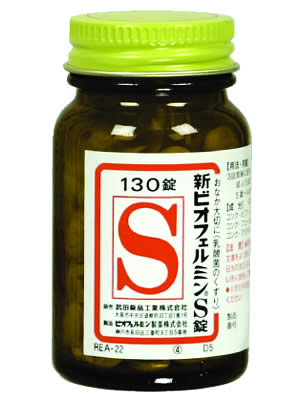
Source of image: http://www.beauty-s.com/site_data/cabinet/kenko126/s211630h_l.jpg
"It's his entrance song, Dagon-a My House." (17:55)
This is a referencing "Come on-a My House", a song sung by Rosemary Clooney and released in 1951. The background song that plays at this time also sounds like "Come on-a My House".S3 Video for reference: https://youtube.com/watch?v=mriXncI96lw
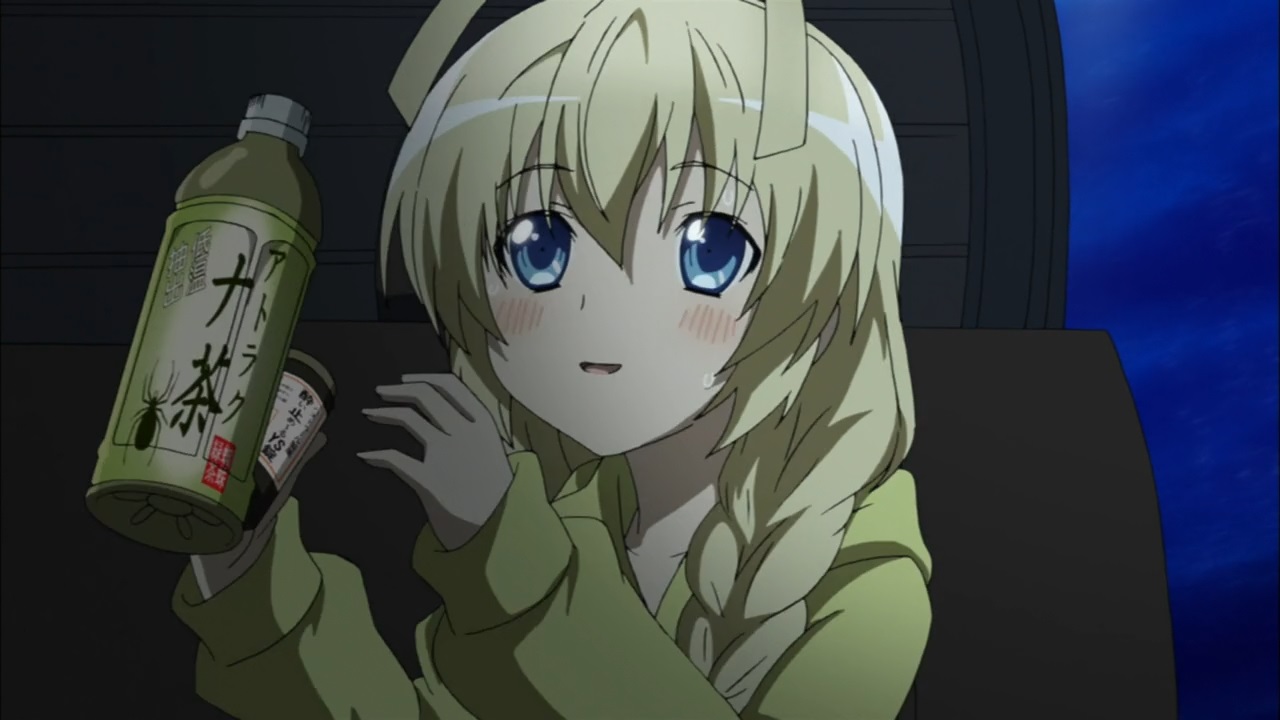
"Atlach-Na-cha" (18:03)
There are three references here:
* The label on the bottle reads "Atoraku Nacha" (アトラク ナ茶), which roughly translates to "Atlach Tea". "Atoraku Nacha" (アトラク=ナチャ) is one Japanese pronunciation of Atlach-Nacha, which is the name of a spider shaped creature classified as a Great Old One in the Cthulhu Mythos.S6
* The most commonly used Japanese pronunciation of Atlach-Nacha is "Atoraku Nakua" (アトラク=ナクア). The specific pronunciation of "Atoraku Nacha" (アトラク=ナチャ) appears to be referencing "Zanma Taisei Demonbein" (斬魔大聖デモンベイン), "Deus Machina Demonbane", a visual novel based on the Cthulhu Mythos that was released by Nitroplus (ニトロプラス) in 2003.S4 In the visual novel, the pronunciation used is "Atorakku Nacha" (アトラック=ナチャ).
* The appearance of the bottle is referencing "Oi Ocha" (お~いお茶), a brand of tea in Japan produced by Ito En (伊藤園).S2 Image for reference:
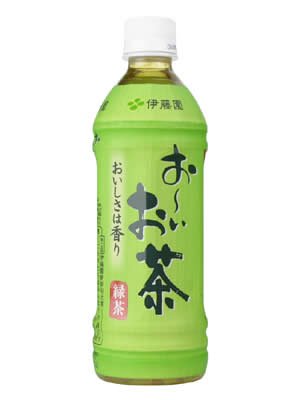
Source of image: http://blog.goo.ne.jp/maruness2002/e/d42fce51717cdf524d38d12819096fb2
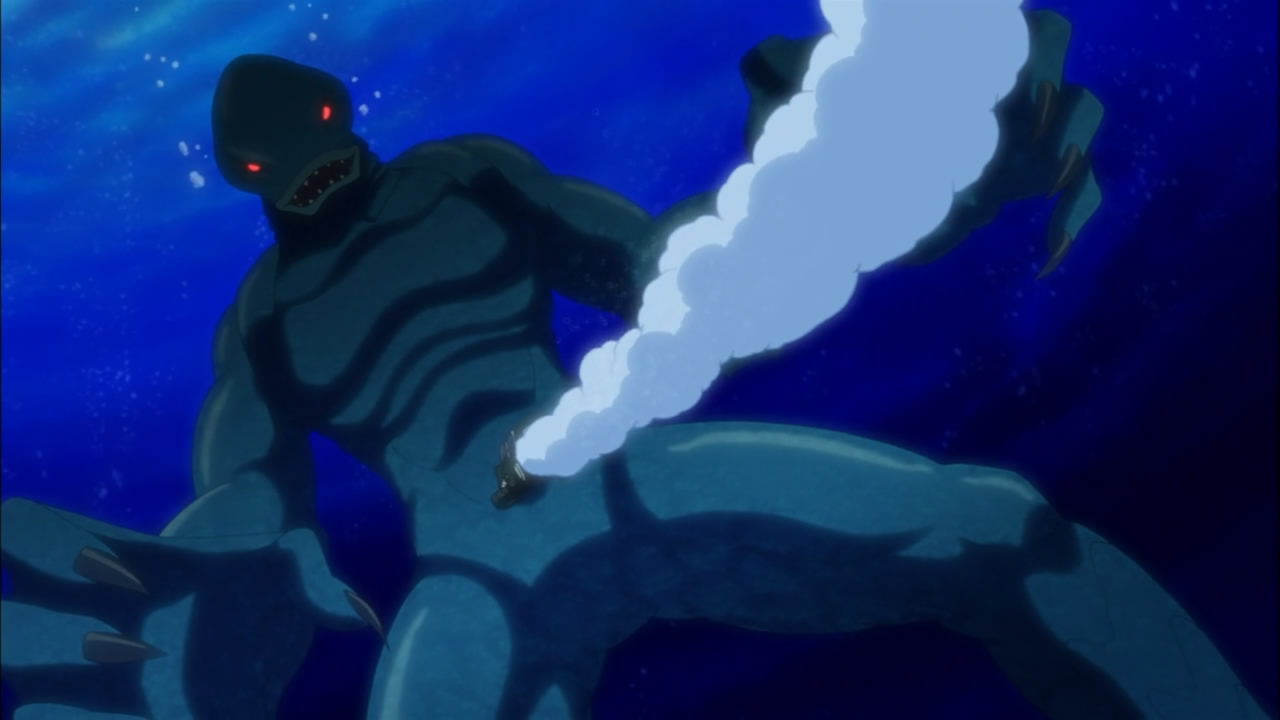

(18:11), (18:39)
As mentioned in episode 2, Dagon and his partner, Hydra, are both enormous sea dwelling creatures that serve Cthulhu in the Cthulhu Mythos. They are also known as Father Dagon and Mother Hydra, and they rule over the Deep Ones, a species of sea dwelling creature in the Mythos. In "Dagon", a short story written by H. P. Lovecraft and first published in 1919, Dagon is described as follows:
"Vast, Polyphemus-like, and loathsome, it darted like a stupendous monster of nightmares to the monolith, about which it flung its gigantic scaly arms".

(18:44)
The expression and pose that Nyaruko makes bear great resemblance to those of Rebecca Miyamoto (レベッカ宮本) in the third opening sequence of "Pani Poni Dash" (ぱにぽにだっしゅ!), an anime series that aired in 2005. Image for reference:
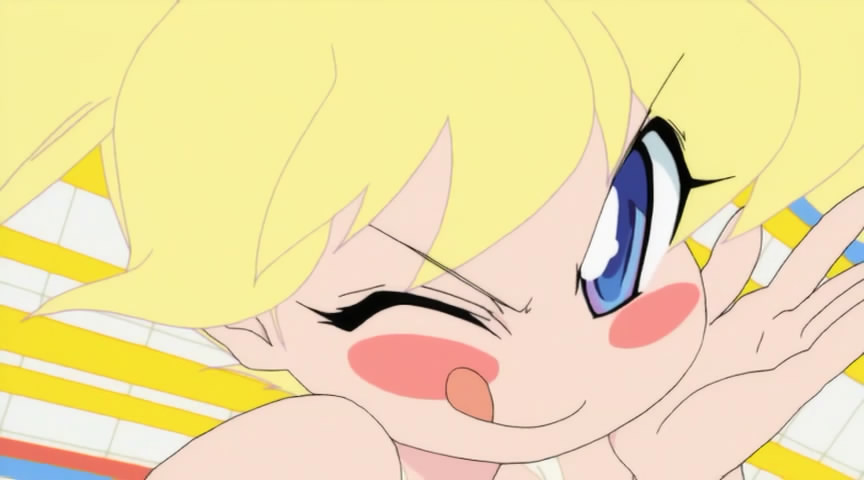
This expression in general appears to be referencing Peko-chan (ペコちゃん), the mascot of the Fujiya Company (不二家).S1 Image for reference:
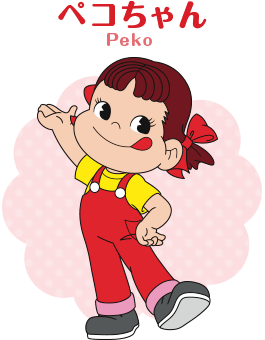
Source of image: https://www.fujiya-peko.co.jp/pekoroom/profile/
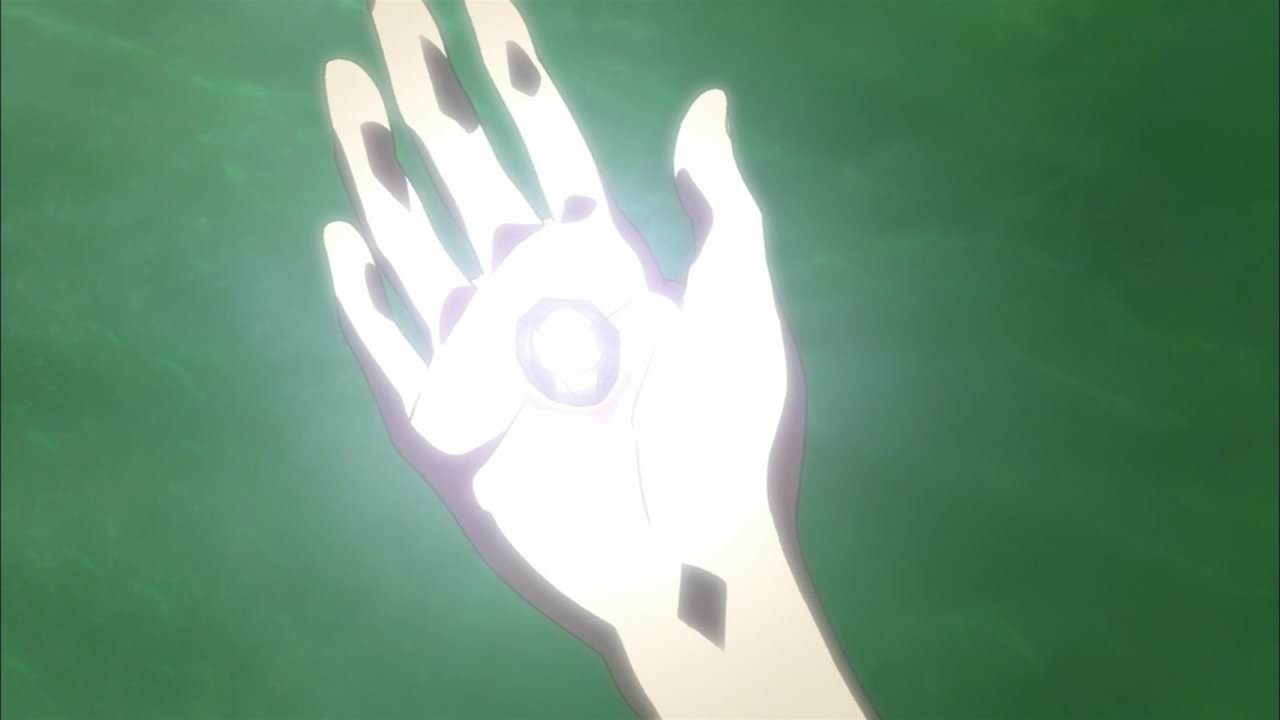
(19:40)
This is the crystal Nyaruko gave Mahiro in episode 2. It is based on the Shining Trapezohedron, a mystical crystal that serves as a window on all of space and time and first appeared in "The Haunter of the Dark", a story written by H. P. Lovecraft and first published in 1936. Like its original it is a "crazily angled stone", rather than a true Trapezohedron.
"It doesn't count. Doesn't count, doesn't count." (20:06)
The Japanese line is "Yue ni kore ha noo kaunto da. Noo kan! Noo kan!" (故にこれはノーカウントだ。ノーカン!ノーカン!). This is a reference to a scene from "Kaiji", a manga series written by Fukumoto Nobuyuki and published from 1996 and is currently ongoing. Specifically, the scene occurs in chapter 41 of volume 4 in "Tobaku Hakairoku Kaiji" (賭博破戒録カイジ), part 2 of "Kaiji" that was originally published from 2000 to 2004. In the scene, Ootsuki tries to convince a crowd that he didn't cheat at a dice game. He claims that his roll, which used unfair dice, doesn't count since the dice hadn't stopped spinning when he was caught, and he repeatedly shouts "No count!" (ノーカウント! Noo kaunto!).S1 Image for reference:
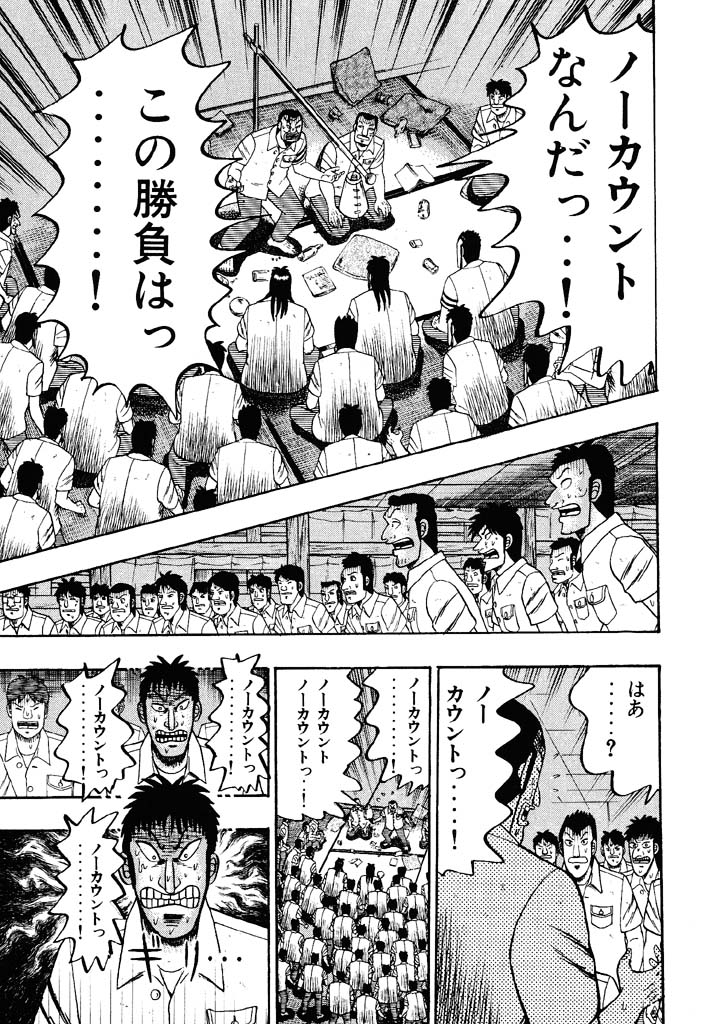
This scene also occurs in episode 8 of season 2 of the anime adaptation of "Kaiji" that aired in 2011. Ootsuki's "No count!" line is shortened from "Noo kaunto!" (ノーカウント!) to "Noo Kan!" (ノーカン!).
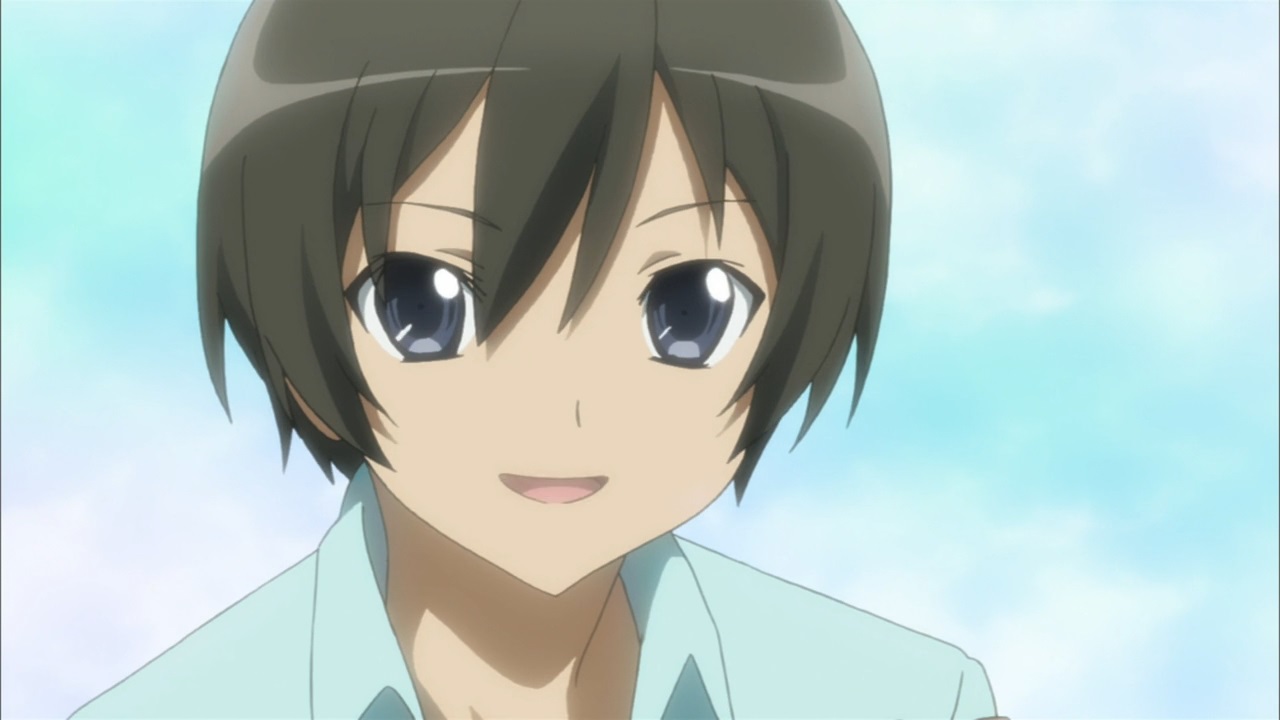
(20:09)
The lines at this time go as follows:
「そんな理論武装で大丈夫か?」This is referencing lines in a trailer released in 2010 for "El Shaddai: Ascension of the Metatron" (エルシャダイ), a video game released in 2011.S1 In the original lines go as follows:
「大丈夫だ、問題ない。」
"Sonna riron busou de daijoubu ka?"
"Daijoubu da, mondai nai."
"Is that theory good enough?"
"No problem. Everything's fine."
ルシフェル: 「そんな装備で大丈夫か?」In addition, the background in this scene is referencing the background in the original scene when Enoch says his line. Image for reference:
イーノック: 「大丈夫だ、問題ない。」
Rushiferu: "Sonna soubi de daijoubu ka?"
Iinokku: "Daijoubu da, mondai nai."
Lucifer: "You sure that's enough armor?"
Enoch: "No problem. Everything's fine."
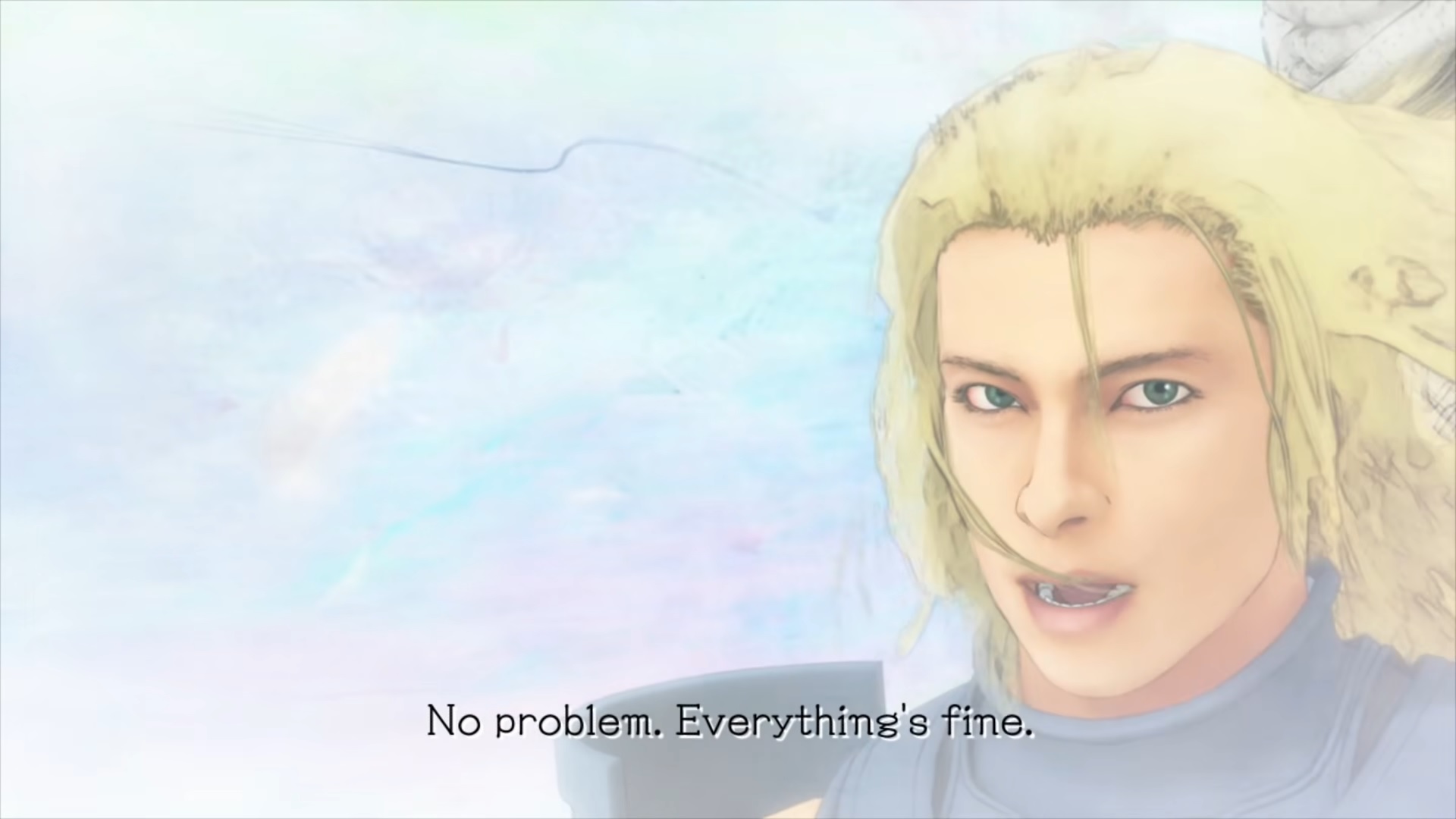
Source of image: https://www.youtube.com/watch?v=p96ortn0ots
"Sometimes love blooms the day two people meet." (20:24)
The Japanese line is "Hitome atta sono hi kara koi no hana saku koto mo aru yo" (一目会ったその日から恋の花咲く事もあるよ). This line is part of the opening catch phrase to the Japanese dating show, "Panchi DE Deeto" (パンチDEデート), "Punch DE Date".S1
"I want to combine with you." (20:33)
The Japanese line is "Mahiro-kun to gattai shitai" (真尋くんと合体したい). This referencing "Sousei no Akuerion" (創聖のアクエリオン), "Genesis of Aquarion", an anime series that aired in 2005. The series features robots that combine to create a more powerful form. Specifically, this line is referencing a slogan used in commercials for "Sousei no Aquarion". The original line goes, "Anata to gattai shitai" (あなたと合体したい), which translates to "I want to combine with you".S2 Video for reference: https://youtube.com/watch?v=sct1EFY6xIo
"The person I love just happens to be a man." (20:41)
The Japanese line is "Boku ga suki ni natta hito ga, tamatama otoko no hito datta dake da mon" (ぼくが好きになった人が、たまたま男の人だっただけだもん). This is referencing a line said by Makoto Yuuki (結城誠) in "Yotsunoha" (よつのは), "Four-leaf Clover", a visual novel released in 2006.S2 The original line is "Ore ha, rorikon ja nai. Suki ni natta onna no ko ga, tamatama rori datta dake da" (俺は、ロリコンじゃない。好きになった女の子が、たまたまロリだっただけだ。), which translates to "I'm not a lolicon. The girl I love just happens to be a loli".
"It came to me, like a 'ting!'" (20:48)
The Japanese line is "Tin! to kita n da yo!" (ティン!ときたんだよ!). This is referencing a line said by Takagi Junichirou (高木順一朗) in "THE IDOLM@STER" (アイドルマスター), a video game developed by Metro (メトロ) and published by Namco (ナムコ) in 2005.S1 The original line goes as follows:
「ほう、何といい面構えだ。ピーンと来た!君のような人材を求めていたんだ!」Image for reference:
"Hou, nanto ii tsuragamae da. Piin to kita! Kimi no you na jinzai wo motometeita n da!"
"Oh, what a good expression. It came to me, like a 'ping!' I have been searching for a capable person like you!".
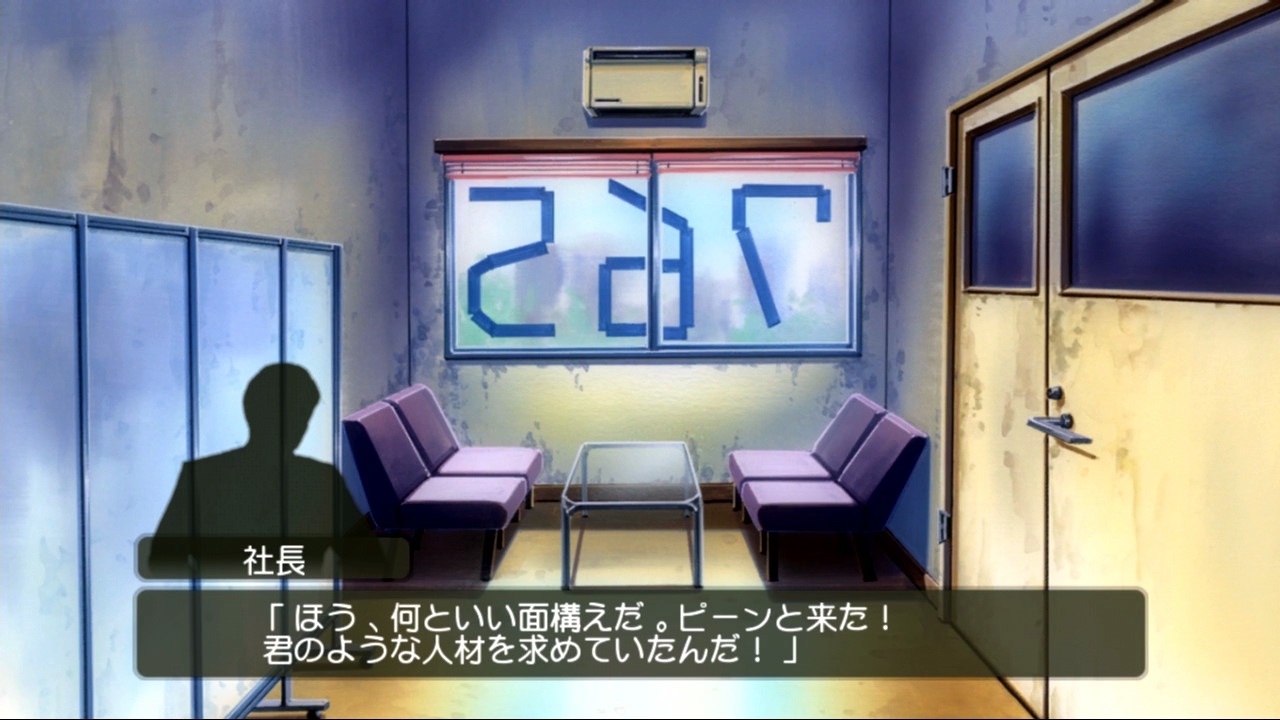
Source of image: https://www.nicovideo.jp/watch/sm13221184
On a related note, Hasta's voice actor, Kugimiya Rie (釘宮理恵), also voices Minase Iori (水瀬伊織) in this game.
"Everyone on this planet moves on a 25 million year cycle. In other words, after that amount of time, this exact situation will happen again." (21:00)
This is referencing a Korean drama that aired in 2006 called 「궁」 (Goong), which means "Palace" in Korean. In Japanese it is localized as 「宮 -Love in Palace-」. In English it is localized as "Princess Hours". Specifically, Mahiro's line is referencing lines in episode 15 between Lee Shin (이 신) and Shin Chae-kyeong (신채경), the two main characters.S7 The lines go as follows, Chae-kyeong's line comes first:
신채경: "우와. 별 좀 봐. 쏟아질 것 같애."The book in question is "Eunbiryeong" (은비령), written by Lee Sun-won (이순원) and first published in 1997.S8 Thanks convexity for Korean transcription help. Japanese translation is from the Japanese subtitles for the show. English translation is from Crunchyroll.
이 신: "별들에겐 별의 시간이 있어. 인간에게 인간의 시간이 있듯이."
신채경: "우와, 신군은 그런 거 도대체 어디서 알어?"
이 신: "야, 책 좀 봐라. 책 좀. 내가 좋아하는 단편에 나오는 거야. 그 책에 의하면 대부분의 행성들이 자기 자리로 돌아오는 공전주기를 가지고 있듯이 사람들도 정해진 주기가 있대. 2500만년. 지금부터 2500만년이 지나면, 지금 우리가 겪고 있는 일들을 다시 겪게 되고, 만났던 사람들을 다시 만나게 된대."
신채경: "그럼 그 책대로 하면 우리도 2500 만 년 후엔 다시 만나겠네?"
이 신: "그런 셈이지."
シン・チェギョン: 「うわぁ。星を見て、落ちてきそうよ」
イ・シン: 「人間に時があるように星にも星の時間がある。」
シン・チェギョン: 「うわ、そんなの、どこで教わるの?」
イ・シン: 「少しは本を読め。好きな短編に出た。その本によると、惑星が公転周期を持っているように、人間にも周期があると。2500万年。今から2500万年後には、今と同じような経験をし同じ人と再会するそうだ。」
シン・チェギョン: 「その本のとおりなら私たちも2500万年後に再会ね。」
イ・シン: 「そうだな。」
Shin Chae-kyeong: "Wow, look at those stars! They look like they're going to pour down on us."
Lee Shin: "The stars have a time of their own, just like people have a time of their own as well."
Shin Chae-kyeong: "Wow. Where did you learn stuff like that?"
Lee Shin: "Why don't you read once in a while? It's from one of my favorite novels. According to that book, just like most planets have a period of revolution until they come back to their place, people have their set period, too. It's 25 million years. It says that in 25 million years from now, we'll be experiencing the same things we're going through right now again, and we'll meet the same people again, too."
Shin Chae-kyeong: "So according to that book, we'll see each other again 25 million years later, too, right?"
Lee Shin: "That's right."
On a related note, Mahiro originally tells Hasta about the 25 million year cycle in chapter 4 of volume 4 of the "Haiyore! Nyaruko-san" light novel series. It is stated that Mahiro learned about it in a book about the dining habits of European royalty and aristocrats.S1
"Pinky swear, swallow 1,000 cups of water from the Lake of Hali if you lie." (21:32)
There are two references here:
* The Lake of Hali is a lake associated with Hastur in the Cthulhu Mythos.S1 It is first mentioned in "The King in Yellow", a book written by Robert Chambers and published in 1895. In "The Seal of R'lyeh", a short story written by August Derleth and first published in 1957, Hastur is described as "Hastur, who reposed at the Lake of Hali in the Hyades".
* The Japanese line is "Yubikiri genman uso tsuitara hariko no omizu senbai nomasu" (指切りげんまん嘘ついたらハリ湖のお水千杯飲ます). This is referencing a song sung when performing a pinky swear in Japan. The original song goes, "Yubikiri genman uso tsuitara hari senbon nomasu" (指切りげんまん嘘ついたら針千本飲ます), which translates to "Pinky swear, swallow 1,000 needles if you lie".S1 On a related note, the reference to the Lake of Hali is likely a pun on the Japanese pronuncation of Hali, "Hari" (ハリ), and the Japanese word for needle, also pronounced as "hari" (針).
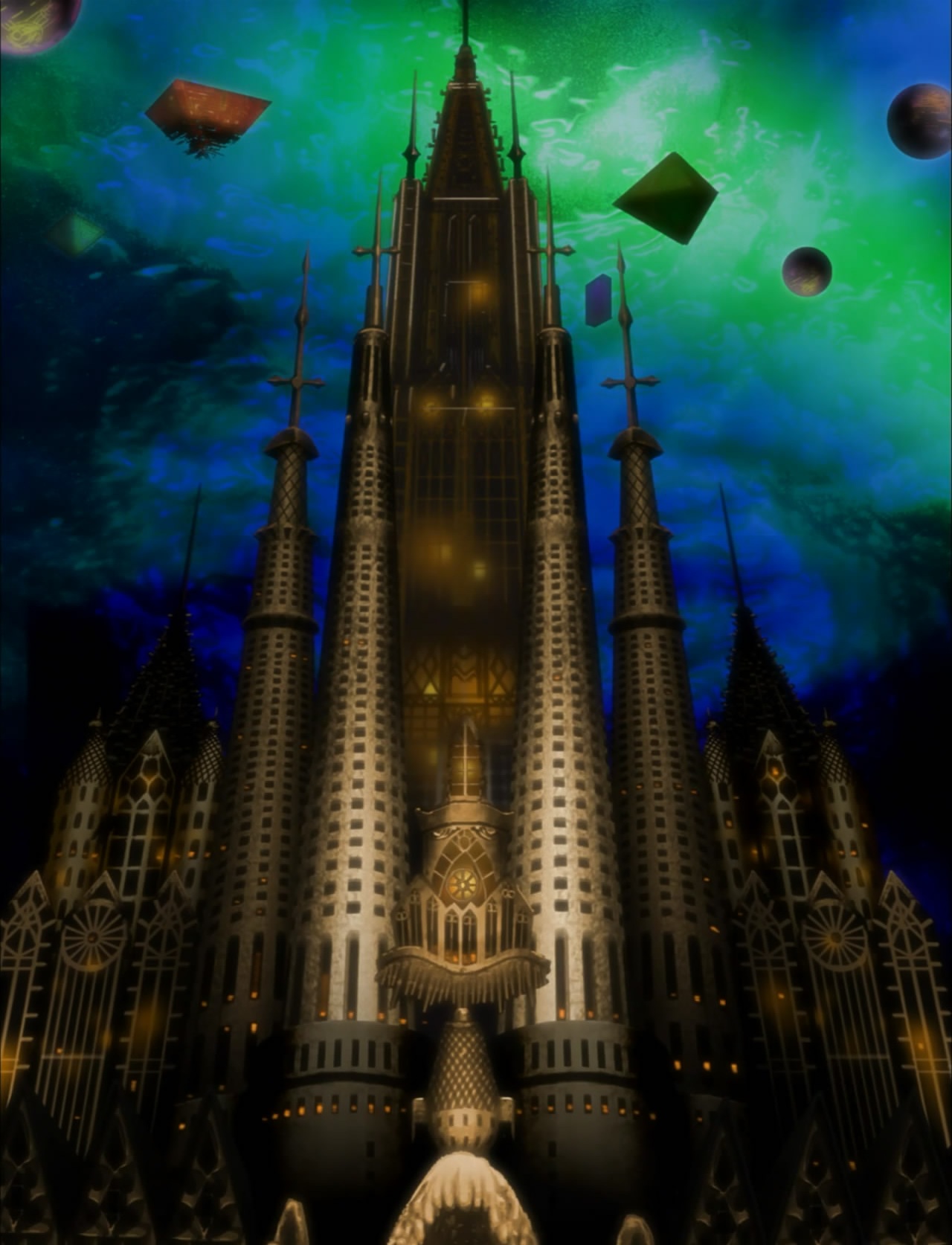
(21:52)
The auction house from episode 2 appears, again. As mentioned before, it bears great resemblance to the Sagrada Familia church in Spain. In particular, it resembles concept drawings and models of how the church would look once completed.S1 Image for reference:
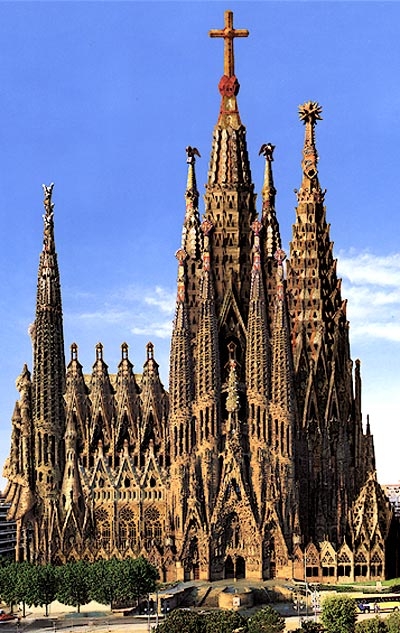
Source of image: http://www.gaudidesigner.com/uk/sagrada-familia.html
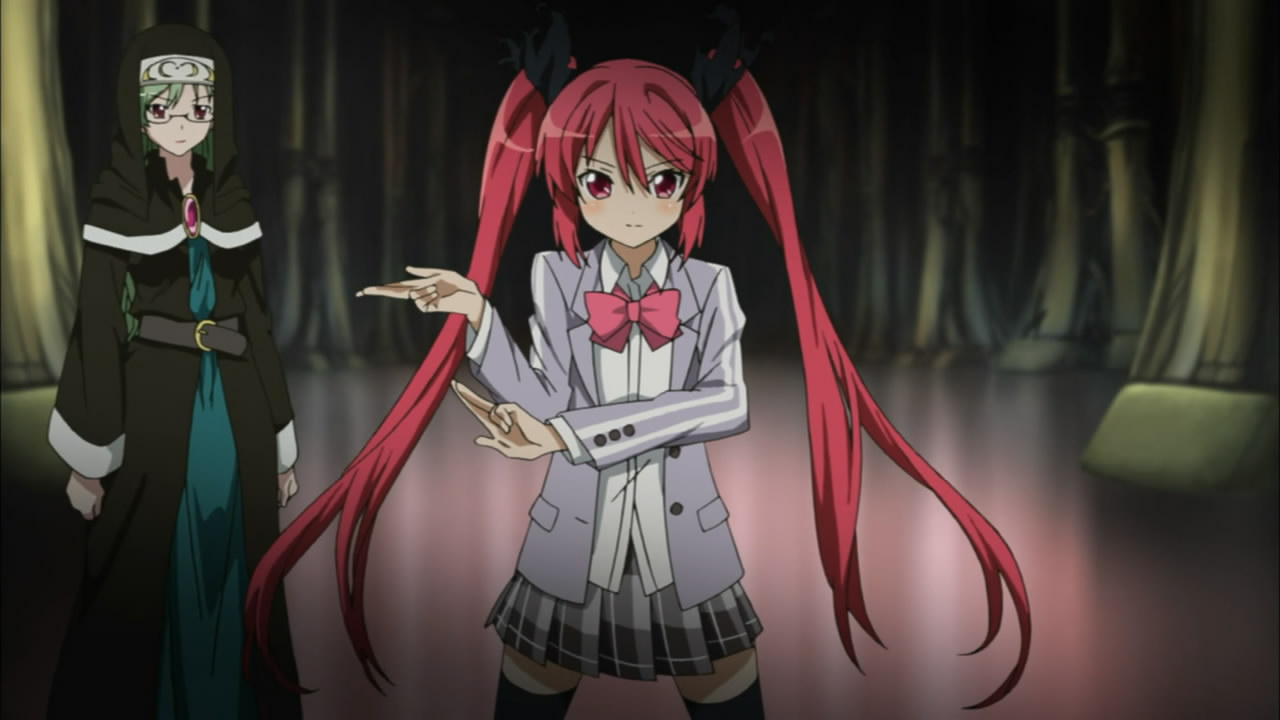
(22:03)
Cthuko's pose is referencing that of Kamen Rider Super-1 from "Kamen Rider Super-1" (仮面ライダースーパー1), a Japanese TV show about a masked super hero that aired from 1980 to 1981.S2 Image for reference:
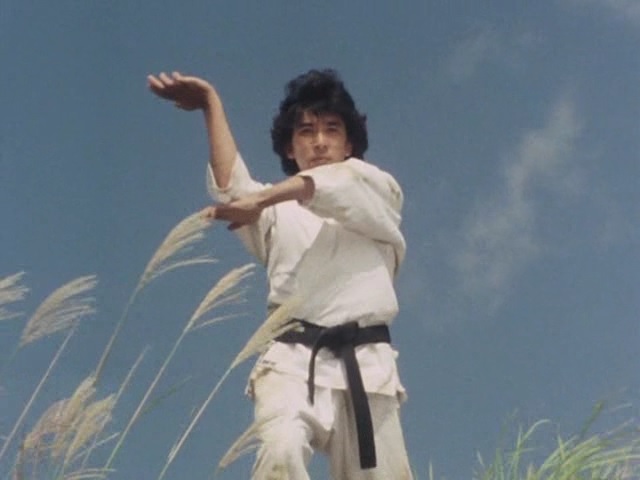
"25 years of life as a teacher." (23:45)
The Japanese line is "Kyoushi seikatsu nijuugo nen" (教師生活25年). This is referencing the same phrase often said by Machida (町田先生) in "Dokonjou Gaeru" (ど根性ガエル) "The Gutsy Frog", a manga series written by Yoshizawa Yasumi (吉沢やすみ) and published from 1970 to 1976.S1
"The next episode is 'The War in the Market.'" (23:50)
The Japanese title is "Maaketto no Naka no Sensou" (マーケットの中の戦争). This is referencing "Kidou Senshi Gandamu 0080 Poketto no Naka no Sensou" (機動戦士ガンダム0080 ポケットの中の戦争), "Mobile Suit Gundam 0080: War in the Pocket", an anime series released in 1989.
List of sources:
S1. Comments on this post
S2. A post at Steman Blog (ステマブログ)
S3. Japanese Nyaruko References Wiki (這いよれ! ニャル子さん 元ネタwiki) - Nyaruko Episode 5
S4. Japanese Nyaruko References Wiki (這いよれ! ニャル子さん 元ネタwiki) - Nyaruko Light Novel Series Volume 4, Chapter 3
S5. A note posted on Yahoo 知恵袋 (chiebukuro) by harehorehireharev3
S6. A blog by servitors about Cthulhu Mythos inspired works (クトゥルー/クトゥルフ神話作品発掘記)
S7. "Haiyore! Nyaruko-san" annotations by hirapro
S8. 宮 -Love in Palace- @wiki
S9. "Encyclopedia of Japanese Business and Management" By Allan Bird
Thanks to everyone who contributed! This list wouldn't be nearly as long without you all. See you next episode!
情報を教えてくださって本当にありがとうございました!皆さんがいなかったら、このリストはぜんぜん長くありません。またこの次までね!
Last updated July 12, 2012
Sitemap
Home
